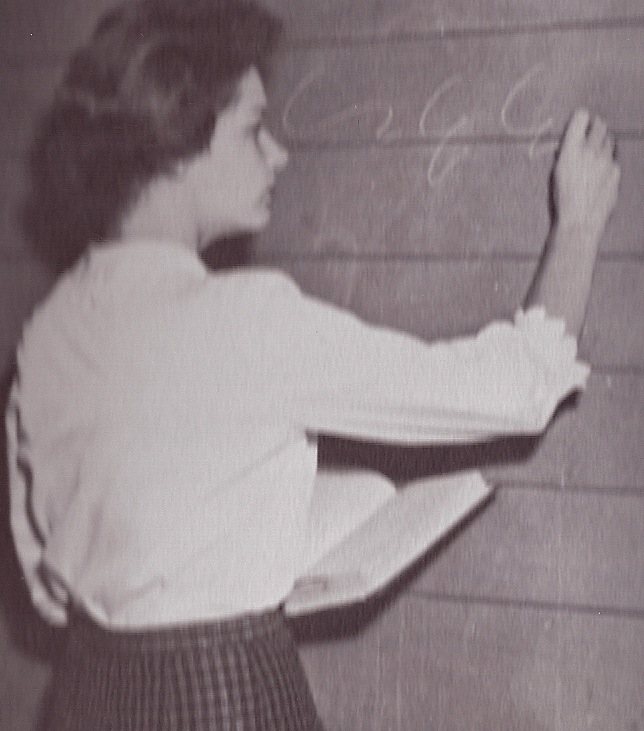
Cory60.com
High School
Your Online Class Reunion
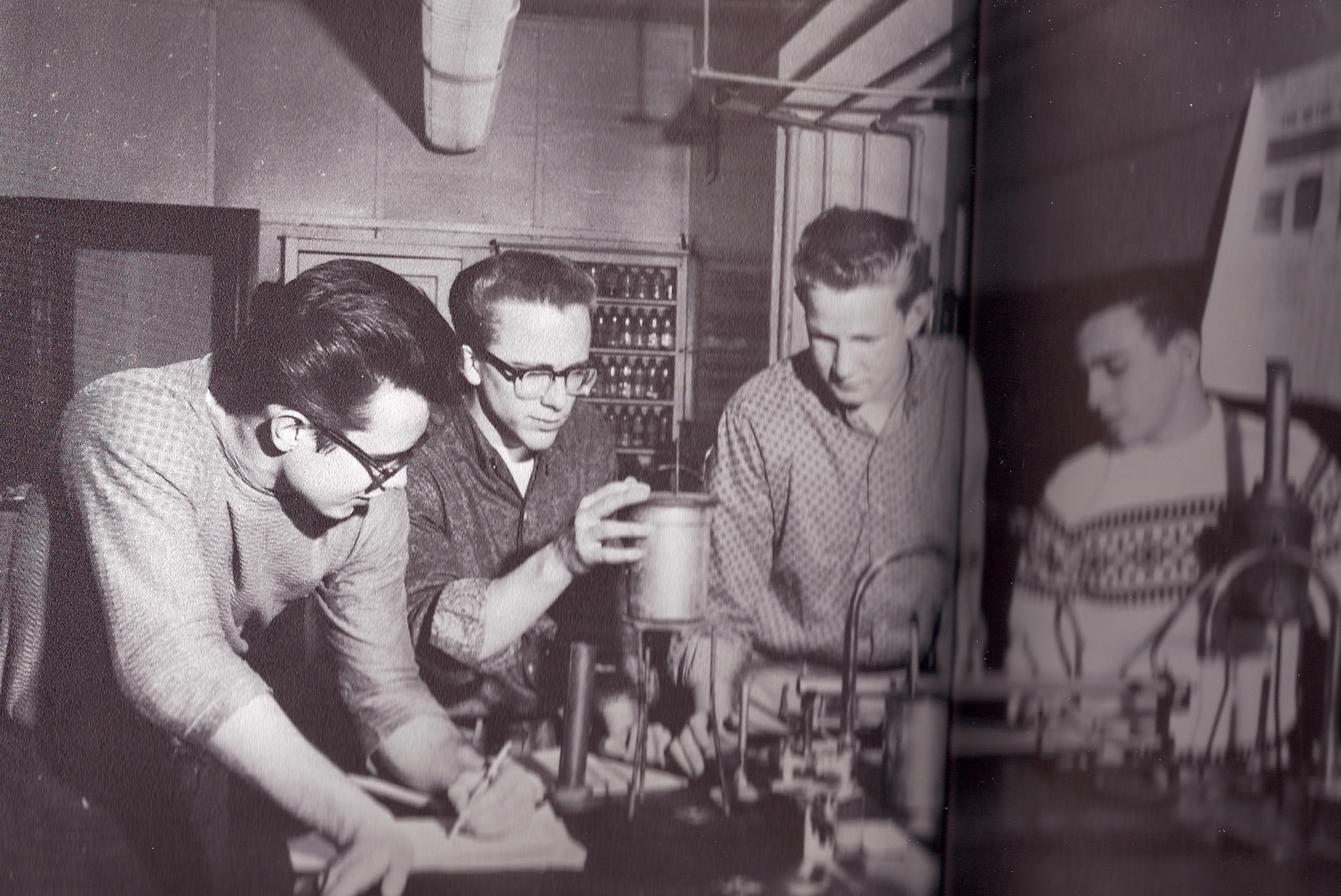
 |
Cory60.com High School Your Online Class Reunion
|
 |
| Students everywhere complain about their schools. We did our share of it. But looking back, we could not have had a better experience. Our school was large enough to offer a wide range of activities, but small enough anyone who wanted to participate in any of them was welcome. We were large enough to offer collegebound, business and vocational courses, but small enough to know each other by first names. We were Black, German, Italian, Jewish, Hungarian, Polish and Scotch Irish, but we not only got along, but enjoyed visiting each others' homes and sampling all the nationality foods, especially at holidays. We had jocks, bandies, greasers and geeks, but the same kids often played the different roles at different times. Some of our best athletes were also our best students. Some of our best looking girls were also our most athletic. We had a great drummer who was also a great dancer and a gifted artist and became an architect. One of our football players graduated from Harvard and became a venture capitalist and sailor. A three sport star earned his doctorate and became a college administrator. The kid who set pins at the bowling alley went on to found his own corporation. A cheerleader became a psychologist. Our Buddy Holly Fan Club president majored in forestry and plant pathology and administered Tongass National Forest in Alaska. Our best writer became a college athlete before sidelined by an ACL injury. One of our greatest party girls became a horse breeder and shower. All in all, we were quite a bunch. |
|
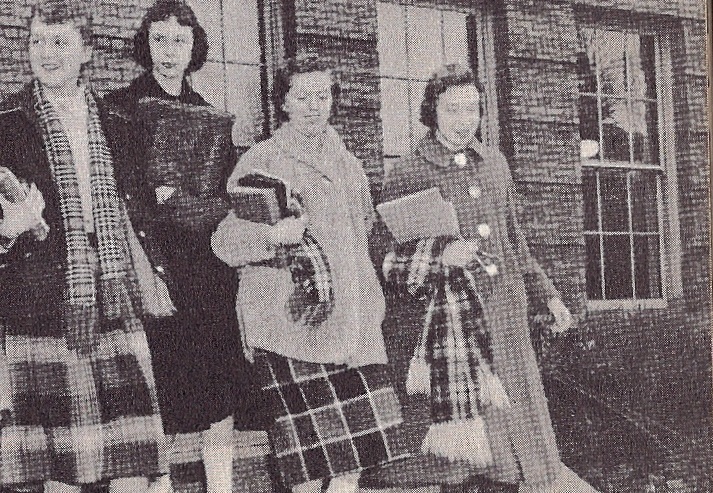 |
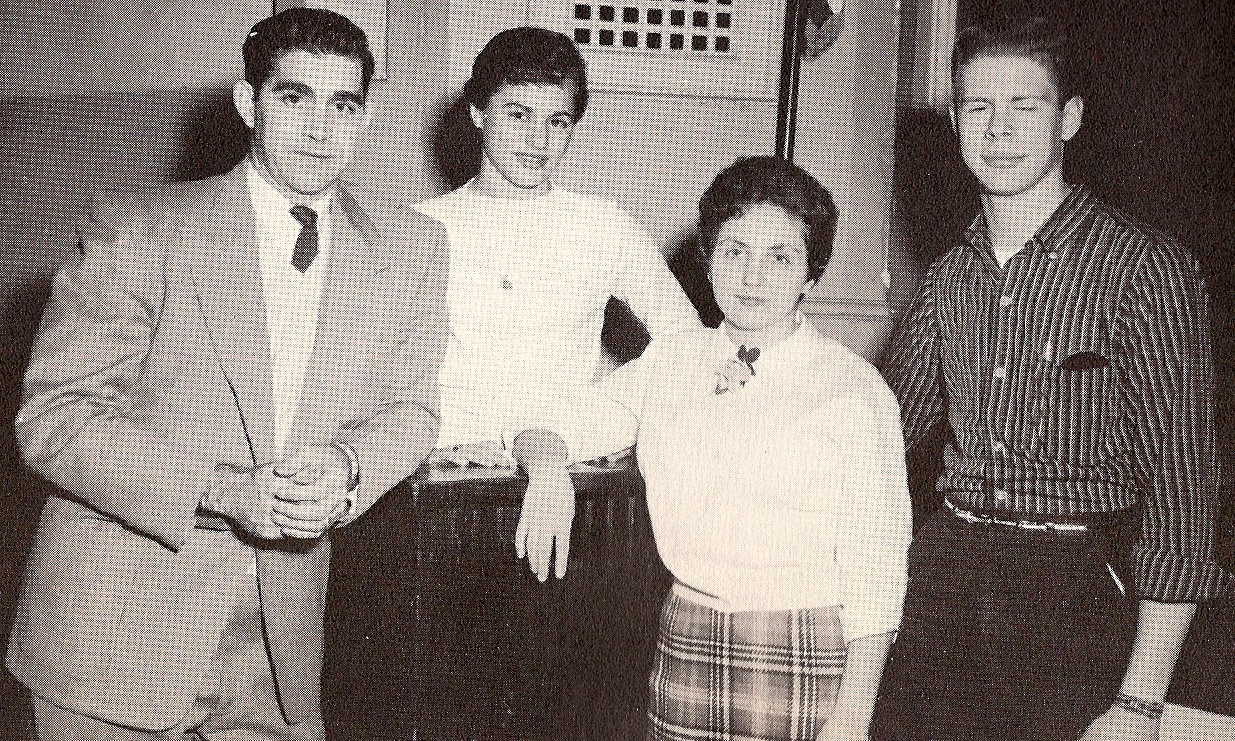 |
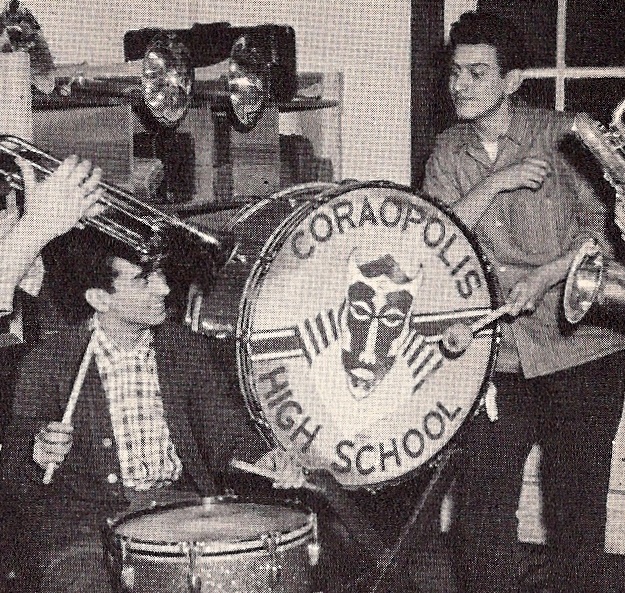 |
We were one of the last high schools in America to operate without buses. They gave us 90 minutes to walk home, eat lunch and walk back. Those of us who lived closer had time for a nap or a driveway basketball game. The hilltoppers had to walk pretty fast both directions. But making two full round trips a day in deep snow, driving rain and blazing sun kept us all in pretty good shape. We came in all shapes and sizes except fat. At right, Tony and Ken pause on the backsteps before heading back to school on a warm sunny May lunch break. We did have a strong tax base with 11 mills in town, but one of the reasons our school was in strong financial shape was that we did not support a bus fleet. Today, the most cost consuming part of a school system is transportation. After they merged Coraopolis with Neville and went to buses, they started sinking slowly into financial trouble.
|
 |
 |
During our three years in high school Danny continued to work down at the Coraopolis Record. Most of the articles and many of the photographs now contained in old albums came from his typewriter or camera. By the end of 11th grade the Beaver County Times had also hired him as a correspondent. As a Times reporter, during the Summer before our senior year, he was able to cover the PGA Open Golf Tournament, the Big 33 High School All Star Game in Hershey, home Pirate games and PRA stock car races. Bill Likens, who held Bachelors and Masters degrees in Journalism from the University of Kentucky, sent a portfolio of his work on to the Journalism School there, with a side note to basketball coach Adolph Rupp. |
| Marilyn takes a break from the Christmas holidays at her Vance Avenue home. We all put a lot of time and effort into decorating our homes for Christmas, but Marilyn, having been honing her artistic skills since grade school, placed special emphasis on it. |  |
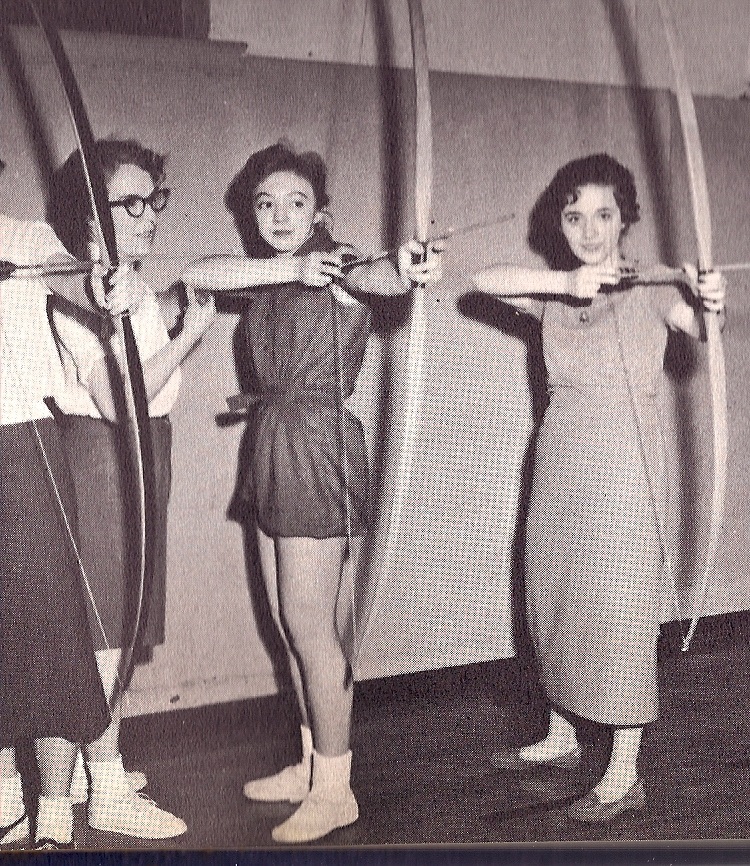 |
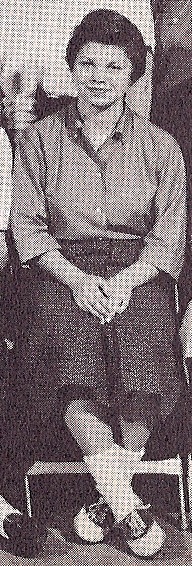 |
 |
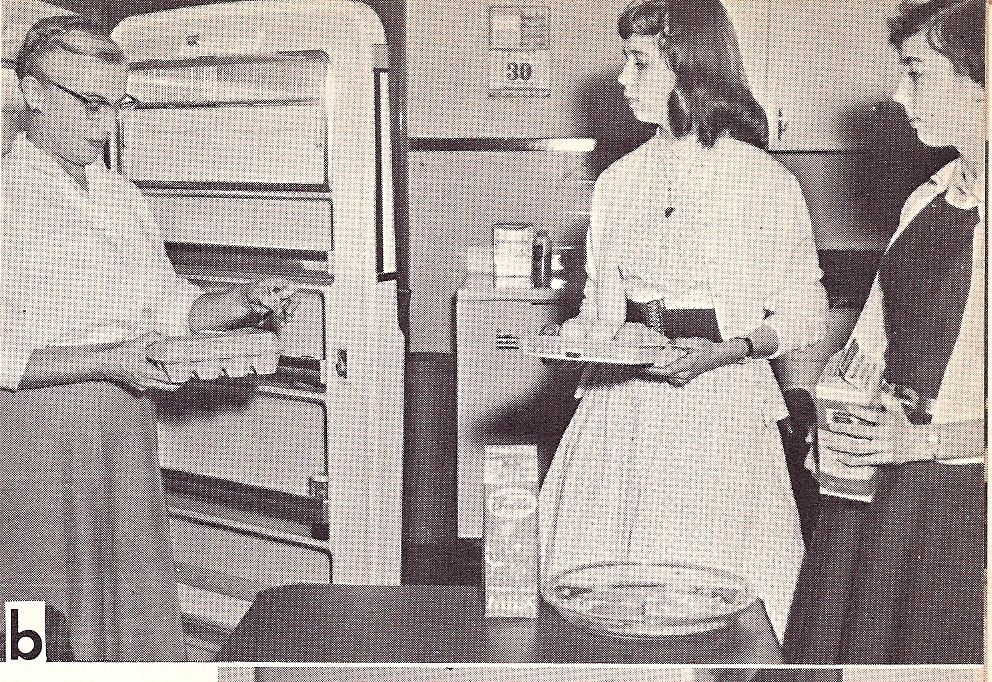 |
When we were in high school, anyone taking Home Ec or "Shop" classes got to walk the three blocks to the junior high, where the home ec complex and vocational facilities were located. Quite a few of us did that, and several ended up pursuing careers in one of the related fields. Ironically, when they merged Coraopolis into the Cornell District, they sold off the junior high and in the new hilltop building did not build either home ec or vocational facilities nearly as good as the ones we got to use for six years, and because of that the students don't have the range of courses we had. One byproduct of our six year program was a national presidency : at the national convention of the Future Home Makers of America, Carol was voted president of the organization. She spent much of her time for the next year involved in that position, and majored in Home Ec at Carnegie Tech. Had she come along after the merger, she would not have had the opportunity to do that. As a matter of fact, in the majority of high schools, Home Ec and vocational courses have been phased out. Students wanting to specialize in those areas are invited to attend separate high schools or Vo-Tech centers. We were lucky enough to be able to stay at our high school and just walk three blocks for part of the day. |
 |
 |
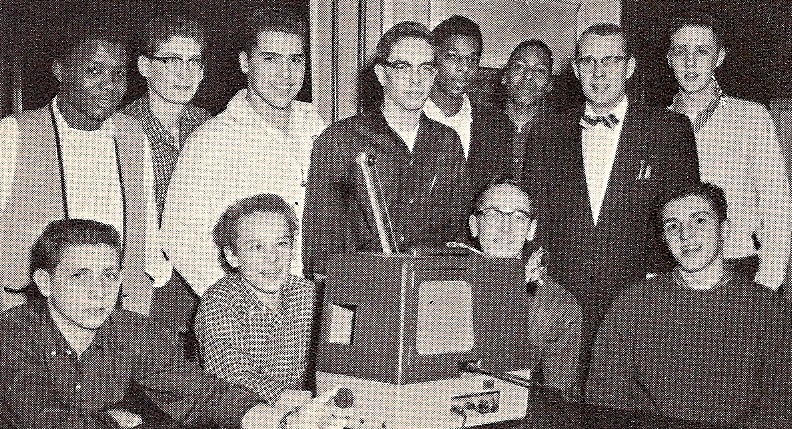 |
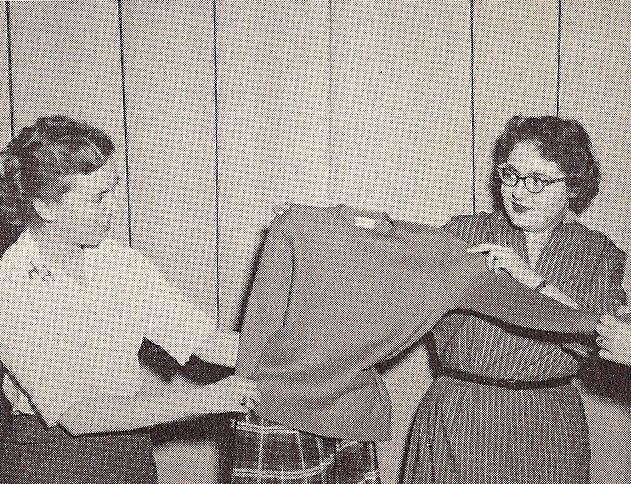 |
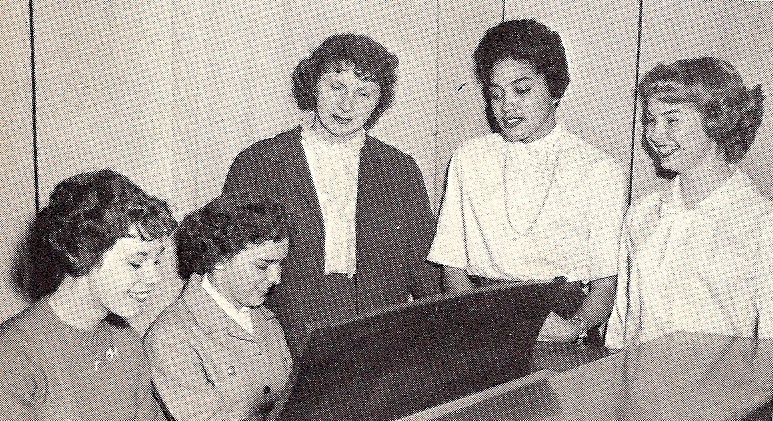 |
 |
| We entered high school in September 4, 1957, the day after Labor Day. Precisely one month later, on October 4, 1957, we woke up to find out Russia had overnight launched Sputnik. They were now first in space. Whoever controlled space controlled the world, and it was a race we could not afford to lose. The American Military Industrial Complex swung into action, and the first thing they did was to throw billions of dollars to science education. We had a pretty good science background already. Down in the elementary schools, Dr. Houtz had made sure the top science students in each grade were brought together into special programs, which usually involved a few Saturday field trips to Pitt or Carnegie Tech and coaching toward the annual Buhl Planetarium Science Fair, in which we were always serious contenders. Houtz had recruited Mr. Bolki from the junior high to handle the day by day details of this grade school effort, but he made sure we had the funding, buses and access to any specialists we needed from the local mills. Tired of losing to us, as we finished the eighth grade, Mt. Lebanon hired Mr. Bolki to take over their science fair program. His replacement was Joseph Rogers, having just finished his doctorate at Montana State University. |  |
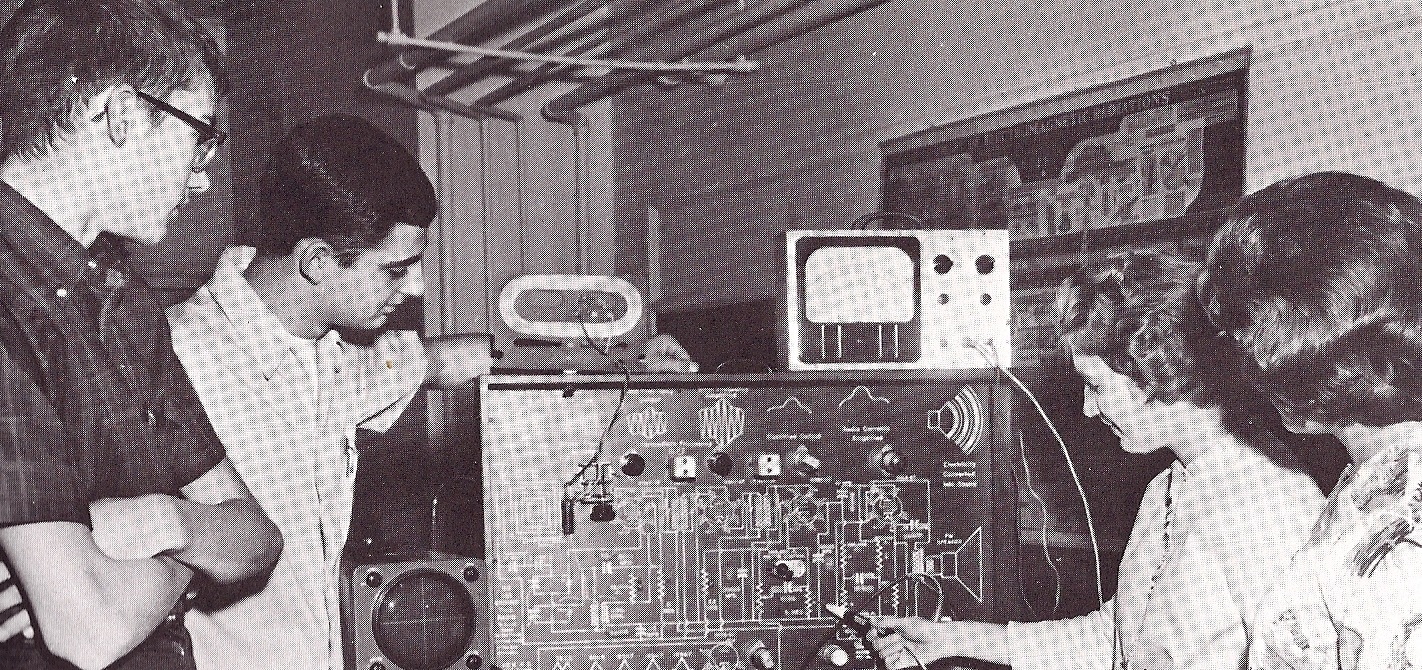 |
Rogers' first move was to replace what he called "Boy Scout Science," meaning playing with chemicals and machinery like one might do with a chemistry set or Erector Set, with what he called Professional Science, meaning mathematically based. We weren't too happy with that. It meant instead of answering simple questions we had to work endless formulas, balance equasions, and learn about moles and atomic weights. We were only in ninth grade, and were just then taking Algebra next door with Dr. Emily Jones. But we struggled on. By the end of the year, we had begun to master this high level material, had come to respect Dr. Rogers, and he felt he had uncovered two dozen or so potential science and engineering prospects. |
Then, just as we moved to the high school, Rogers was also promoted to the Chemistry and Physics position there. This meant he would get us back for 11th and 12th grades. He had already laid a good foundation and looked forward to teaching us on basically a college level. But the high school's labs were antiquated. He needed funding. So as everyone else panicked at Sputnik, Rogers rejoiced. Now he had the money, and he had a year to get ready. He plugged us into the new Harvard High School Challenge Program. For the students not particularly interested in science, it meant a lot more work. But for those of us with a great interest in science, it meant we were suddenly on the cutting edge, with our hands on equipment and instruments never before available in high schools. In Chemistry, we got to study Esthers (the aromatics), Plastics, Organics and Inorganics. Instead of one page cookbook exercises, we got to do legitimate experiments. In Physics, in addition to the Mechanic and Gas and Water Pressure units, we also studied Electricity, Ballistics and Particle Physics. Dr. Rogers taught us about the Schroedinger Equasion and showed us the math behind it. When we got to college, we found we were so far ahead of the other students from much larger high schools that many of us got to skip introductory courses and move straight to the 200 and 300 levels. Truly, we were in the right place at the right time. |
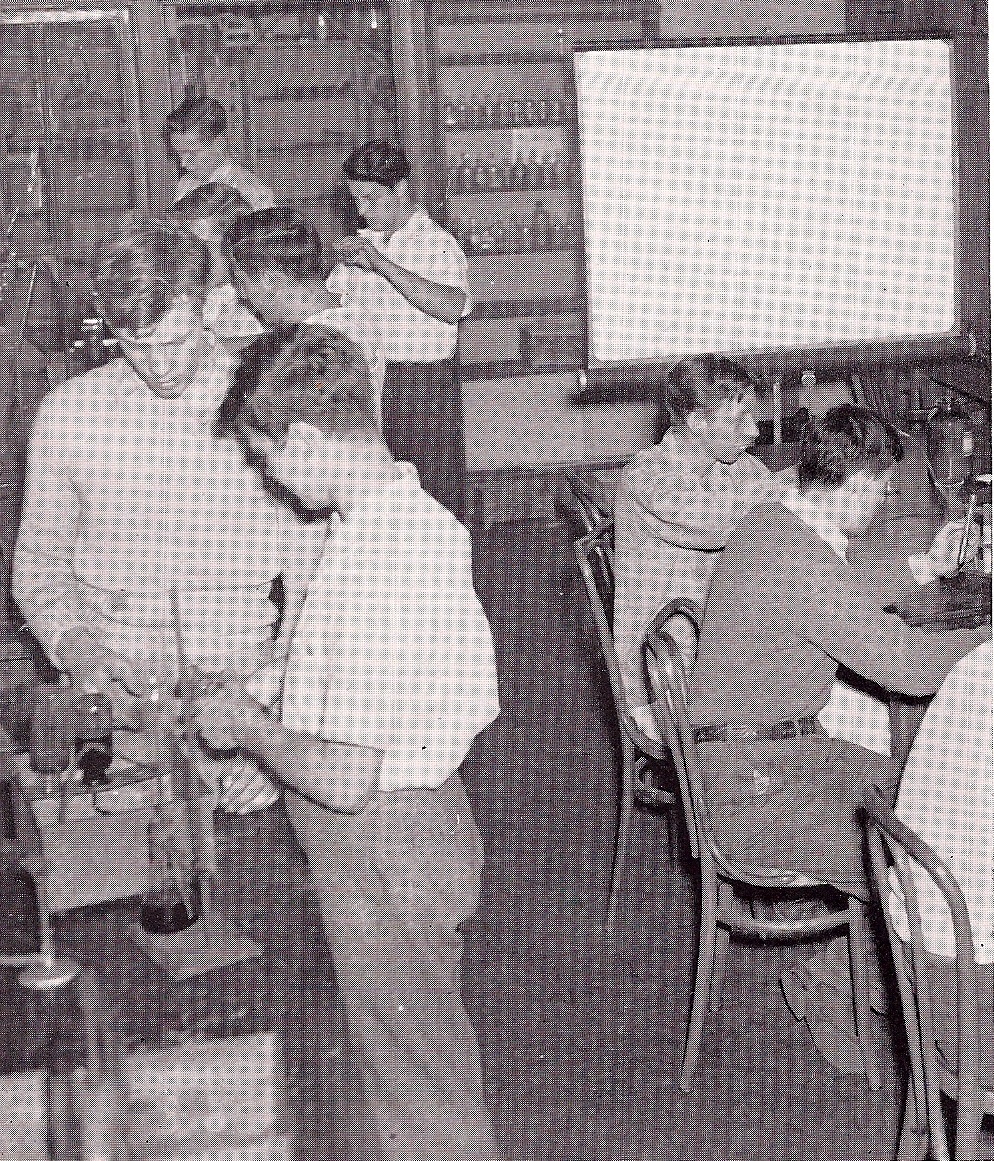 |
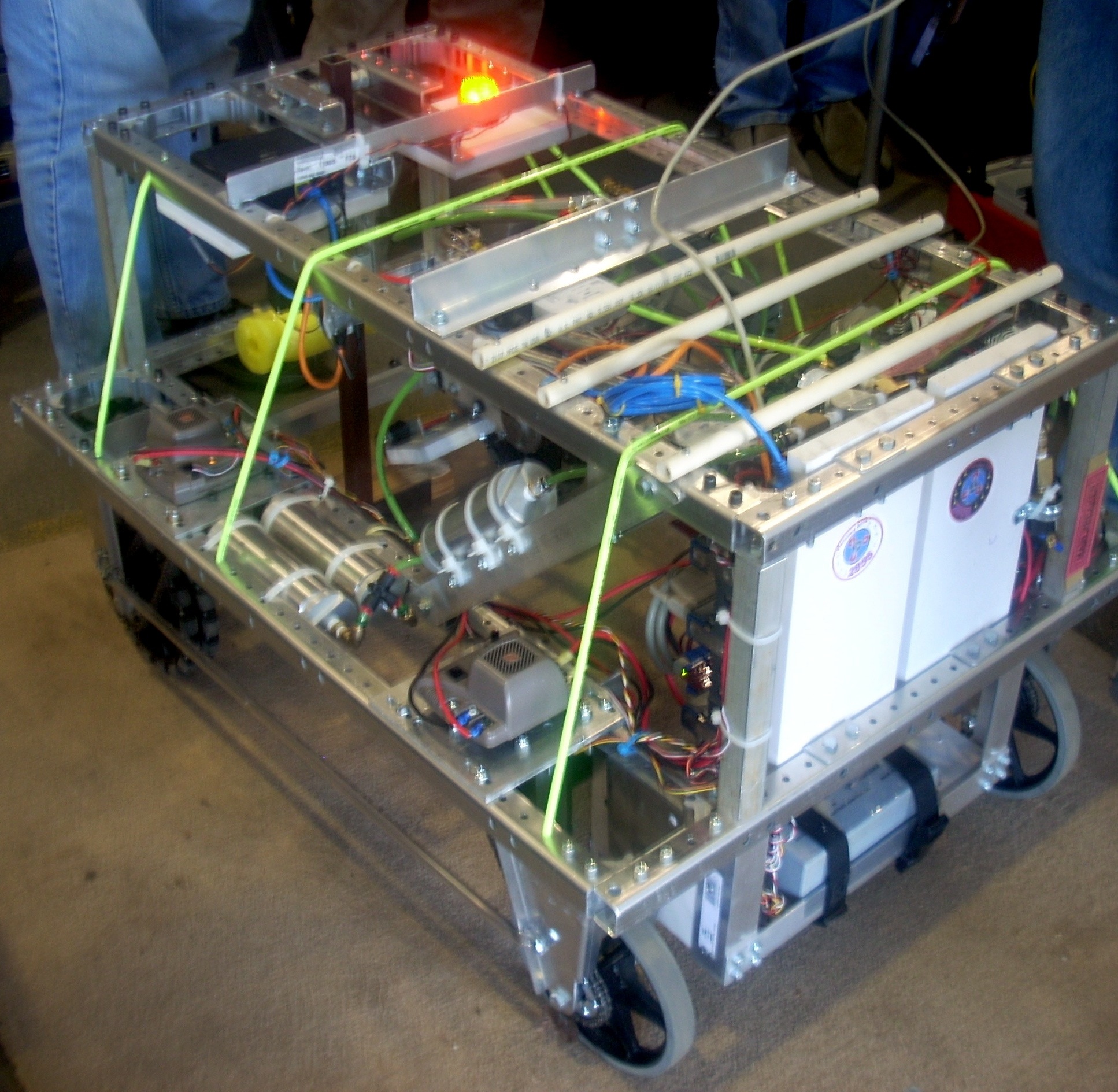 |
Our love of robotics that began back in grade school culminated in this achievement our senior year. With Dr. Rogers' mentoring and numerous after school field trips to Carnegie Tech, we were able to assemble this robot. It carried seven on board servo motors, six compressors, two circuit boards we salvaged from traffic light control boxes damaged by vehicle collisions which took down the telegraph poles they were mounted on but did not damage the circuitry, two photoelectric eyes which allowed it to "see" where it was going (up to a point), and various shunt and redirect circuit boards adapted from our model train accessories. This is still in test mode so we're running it directly from a plug in Lionel ZW model train transformer (not shown). Later we would install two Delco car batteries hooked up in series so the robot would be self sufficient for two hours of running time. We were not allowed to enter this in science fair competition because the judges said it was not an experiment, but merely an elaborate construction project. This was the second time science fair judges turned down a Coraopolis robot because it was "not an experiment." They had done the same thing back in elementary school. This robot could "chase" someone or a ball around the gym, roll up and down a hallway without bumping into either a student coming toward it or any of the walls, and stop when it came to a down staircase because its sensors could detect the end of the floor. If so instructed, it could move side to side quickly enough to keep a student from getting around it in a school hallway. In April of 1960 we displayed it at Carnegie Tech along with other student robots from Mt. Lebanon, Fox Chapel, Peabody, Schenley and Langley. |
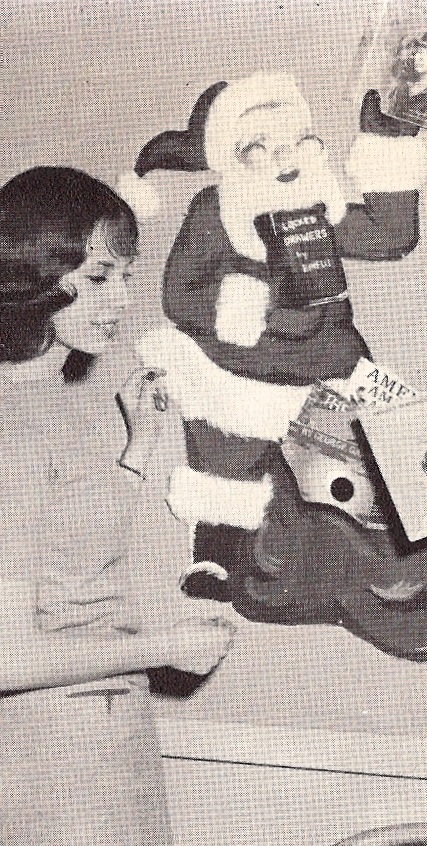 |
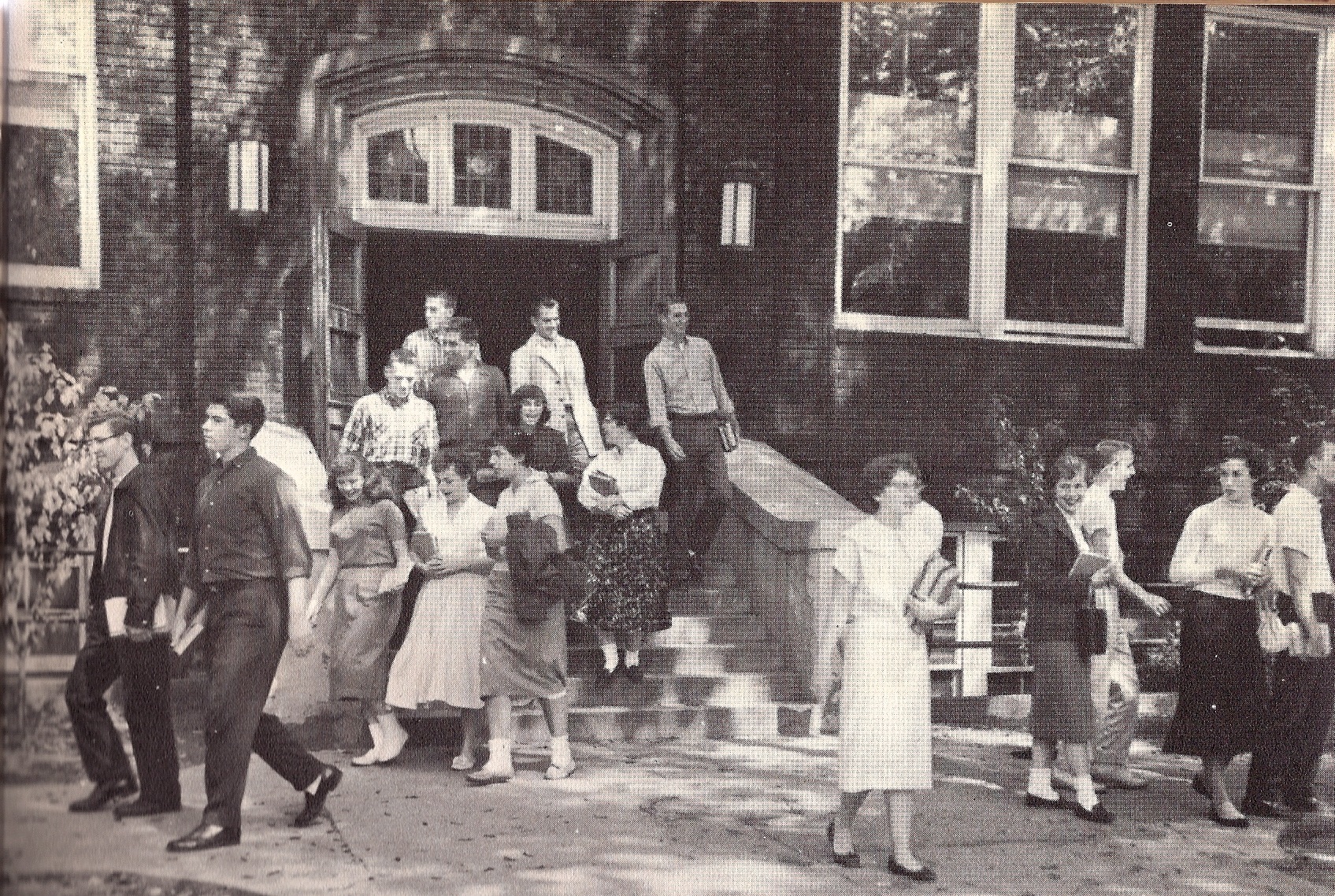 |
 |
|
Coraopolis always hosted an exchange student. We all enjoyed Annie Lunel of France as juniors and Anna Berqvist of Germany our senior year. One of the fringe benefits of hosting the students was that at the end of the year the bus fleet came through picking them up for a tour of the U.S. before the flight home. Families all over town hosted one or two students each while the Foreign Exchange Service used Coraopolis as the base for tours of steel mills and other Pittsburgh attractions. Each year, they would be here for three days. In addition to their scheduled tours, Coraopolis would host them and their host families at a picnic up at the park. Shown here at left are Jeannie and a student from Norway as they decorate the bus for its trip on to Washington, D.C. Below Margaret and Danny enjoy the picnic, students prepare their bus for the next leg of their trip, and Lillian Griffith, the one responsible for whole show coming to town once a year, watches nervously. Ms. Griffith said she was always glad to see the group arrive, but was always glad to see them safely out of town after another successful visit. Since this event always occurred after school was out for the Summer, it was one of the less visible activities. If you were not a hosting family you may not have known it was even happening. Students were invited to sign up for hosting through Ms. Griffith's classes. |
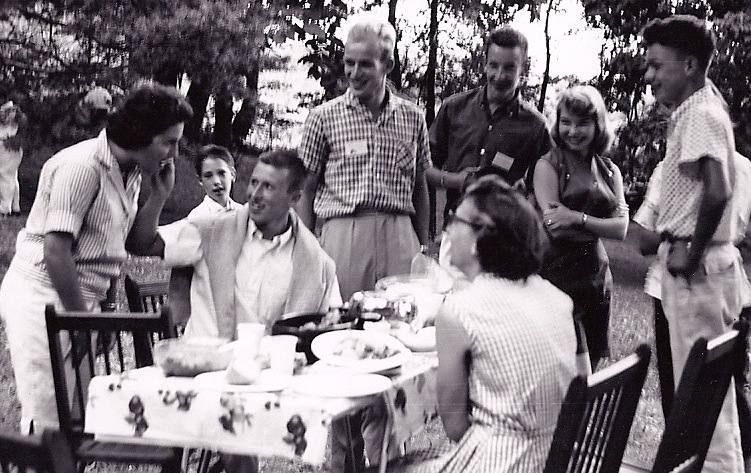 |
 |
 |
Photographs, questions or comments should be directed to Cory at Coraopolis60@aol.com. |
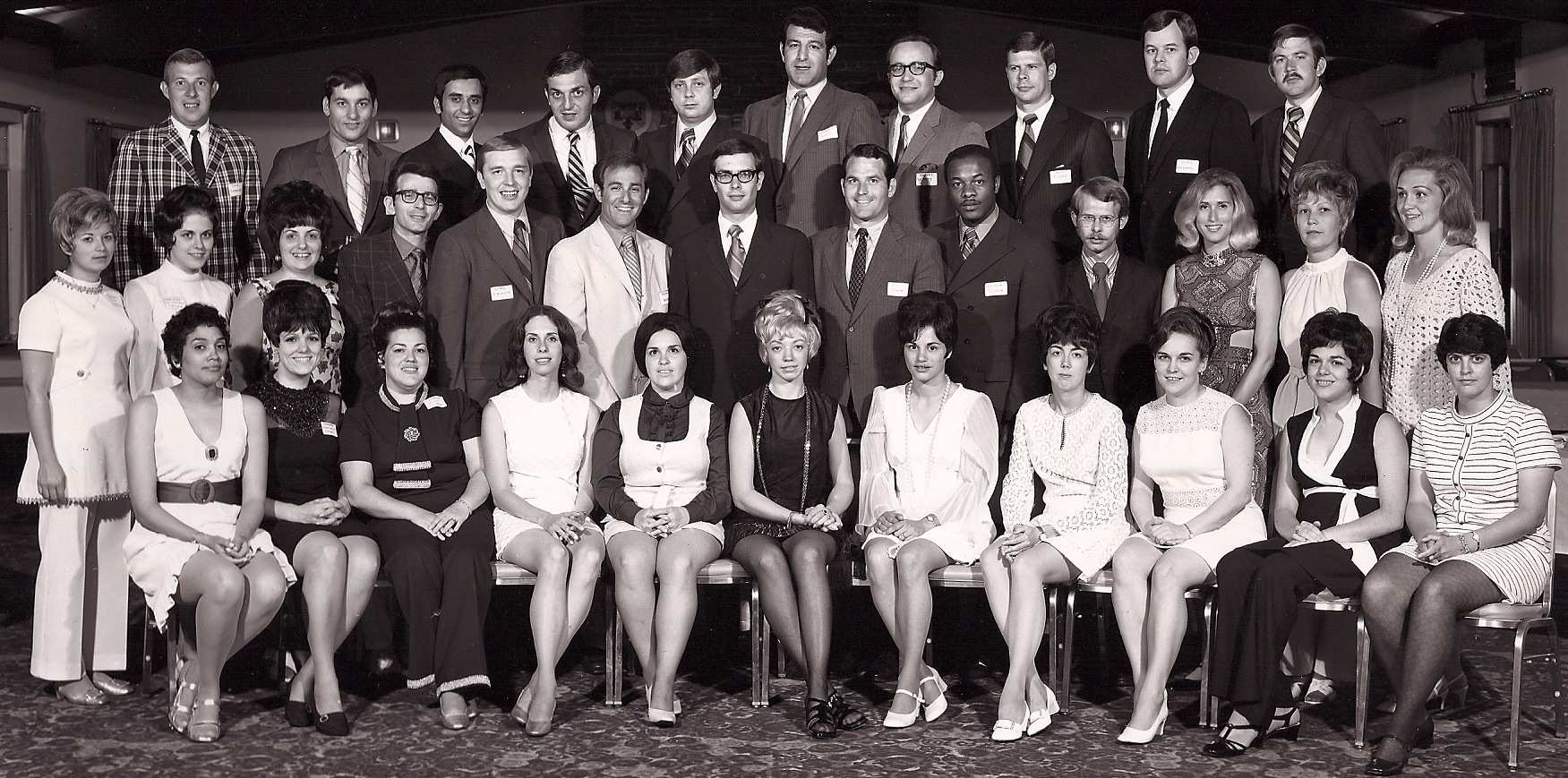 |
| Our June 1970 10th Year Reunion. Seated (L to R) : Harriet, Margie, Harriet, Marilyn, Rita, Gloria, Grace, Charlene, Jacquie, Lucy, Janice. Second Row : Dorothy, Marianne, Elaine, David, Stan, Ron, Dave, Jim, George, Bobby, Michaele, Barbara, Joyce. Third Row : Dave, Ross, Louie, Paul, Joe, Angelo, Bob, Bill, Anthony, George. |
 |
We did love our cars. By senior year many of us were driving to and from school, and another three or four would be riding with those. A few of us had new cars. Most of us had cars five to 10 years old. It didn't matter. We washed, polished, vacuumed and shampooed them until we thought they looked pretty good. |
Eat your hearts out, girls. Oh, not the guy. Forget him. Look at the CAR. Two tone Plymouth Fury convertible with rolled, tucked and pleated naugahyde interior. This was the sharpest car in Coraopolis. Oh, yeh. The guy. That's Bill. |
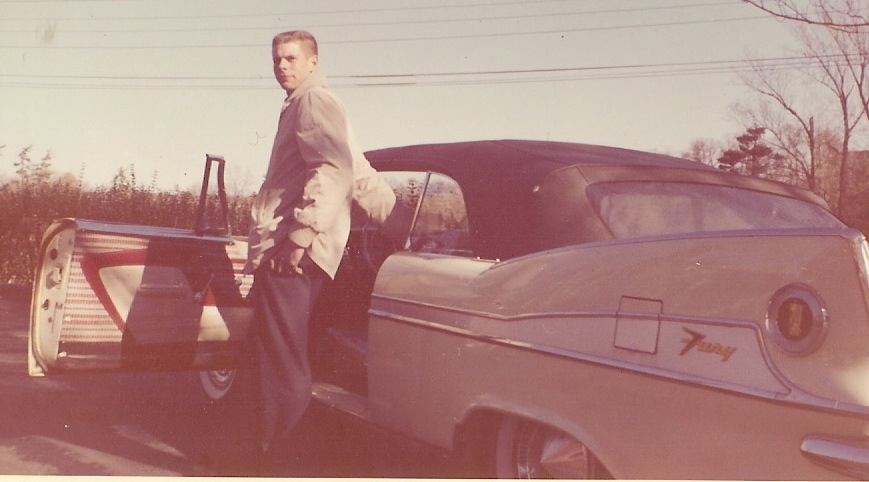 |
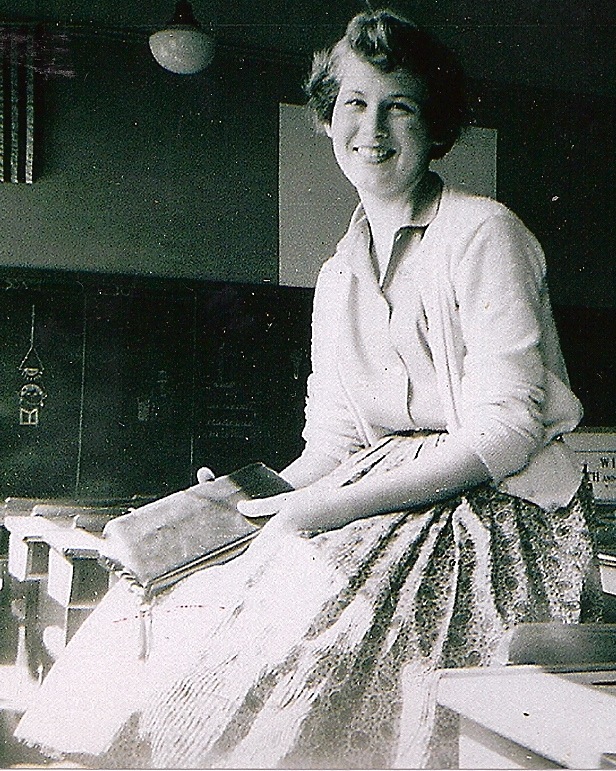 |
Lynette flashes her trademark smile during a break between classes. Most of the guys from Central and McKinley School had crushes on Lynette at one point or another. She was also the victim in the famous remote control model airplane ice bombing incident. Somehow she kept smiling through all the adulation and harassment, and many of the guys fully expected her to end up in Hollywood. Tragically, she was the first of our classmates we lost. |
| There were a lot of great things about our high school but Journalism was not one of them. It had never been a priority so they had invested no money into it. They had never hired a qualified Journalism teacher to either teach a class or handle the newspaper or yearbook, instead rotating a series of English and Social Studies teachers into the roles. Newspaper and Yearbook functioned as clubs, not high level activities leading to competition against other high schools, college scholarships and careers. So by the time we came along, even though we had state of the art programs in math and science and very good English and Social Studies departments, in Journalism and Publications we were one of the weakest out of 150 Allegheny County / Pittsburgh schools. This was particularly unnecessary since only a mile down the street we had The Record, which under Bill Likens and Bill Scholes was named Pennsylvania's best weekly newspaper four times in ten years between 1950 and 1960. Likens had been named National Weekly Editor of the Year. Likens had a masters degree in Journalism from the University of Kentucky and Scholes had his M.A. from Penn State, both top 10 Journalism programs. Both were very interested in Journalism Education. Likens kept offering to teach a class at the high school, print the newspaper on the Record's offset press and let us use their darkroom. The Board repeatedly turned down these offers. In a famous 1957 meeting as we were still in junior high, Dr. William Davies told Likens and the Board, "We bring someone in here to teach legitimate Journalism to these kids, pretty soon we have an amateur army of would be investigative reporters prowling around with notepads and cameras. That can lead to nothing but trouble. We already have enough to worry about." So where, with Likens' help, we might have had one of the state's top Journalism and Publications programs, what we had was 20 years behind the times. |  |
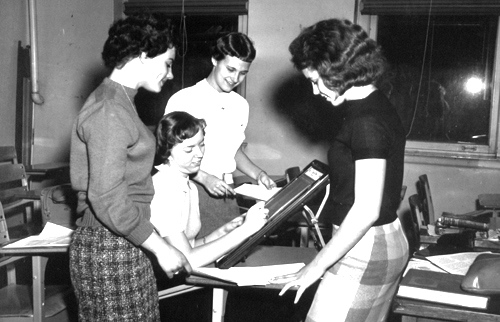 |
During our years in high school, Coraopolis had no darkroom, no light table, no separate rooms for publications so work could be spread out and left incomplete until the staff returned, and no Journalism class for teaching fundamental skills to potential staff members. Furthermore, we had an arcane policy forbidding any student from serving on both staffs in the same year. This was the equivalent of telling Nick or Stan they had to choose between football and basketball. A school of 300 did not have enough talent to spread it that thin. The yearbook did have an hour during the school day and carried class credit, but the newspaper did not. The school paid annual dues to Quill & Scroll, National Scholastic Press Association and Columbia Scholastic Press Association, the three major high school Journalism associations. But we were members on paper only. We did not run chapters, induct members, or elect officers. Most students did not even know we belonged. As part of our membership, Mr. Johnson packed up each year's yearbook and newspapers and sent them off to competition, but when the results were announced each July the school did not bother to inform the students of any awards they won. It assumed they would not win any, so attention was not focused on it. |
During our high school years, it was Gladys Donaldson's turn to sponsor the yearbook. The closest thing to training was that each year, juniors were brought onto the staff so they could look over the shoulders of the seniors and learn by role modelling. A policy left over from the 1940s was that the yearbook had to be distributed at the end of each school year, meaning the staff faced a February deadline. Anything that happened after February 1 was ignored. A "Spring Supplement" was produced by the juniors as part of their training, after which they were assumed to be qualified to put out a whole book. And the yearbook only got half of the available talent. Clearly, this was a recipe for disaster. In sports terms, Ms. Donaldson had no depth and no experience. But like our sports teams, somehow, against the odds, the talent was there. Judy (right) was intelligent, organized, disciplined and a good manager. She would go on to a career as an Oncological Nurse, so Journalism was not her primary focus. But she could rely on others for that. Louie (above right) was a gifted artist whose particular talents ideally suited the magazine format a yearbook uses. Danny had been trained since seventh grade by Mr. Likens at the Record and had already won awards for his writing. Elaine, Margie and Marianne were among the best products of our very strong Business Department, girls who should have gone to college and majored in business administration. Bill, Lucy, George, Janice, Mary Kay, Linda and Mary Ann were quick learners and precise workers. Yearbooks do not require extensive writing or reporting. They require attention to detail. Judy had a staff suited to that. In July of 1960, after we were graduated and gone, the Review was named Best in Pennsylvania in Class B NonColor Division, with Louie given a special citation for his artwork. The school did not even notify students of their success. The two plaques are still on display in the "Coraopolis" trophy collection in the new school complex. The school was not won a publications award since. |
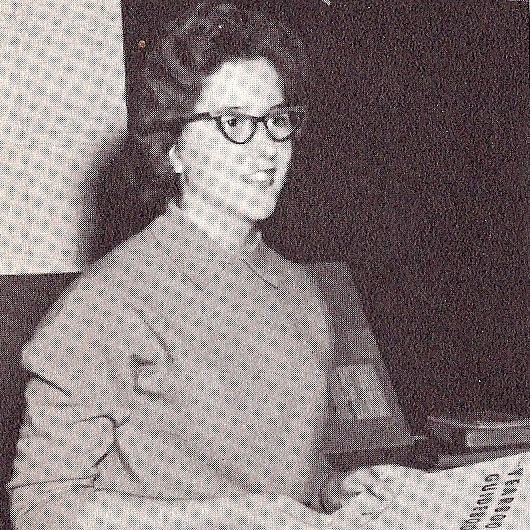 |
|
Carol (left, center) had just served a year as national president of the Future Homemakers of America before she returned home to assume the editorship of the Coralite. She must have wondered what she'd gotten herself into. She had the same disadvantages as Judy but didn't even have the few advantages Judy could count on. There was no class hour; Carol had to put out a paper over one lunch hour a week. The mimeograph equipment was obsolete and she had two advisors, a principal and a superintendant looking over her shoulder in case she got any bright ideas about aggressive reporting of controverial issues. Carol realized she wasn't going to win any championships with these limitations. But her half of the publications pool also included some strong talent : DavidH and Kathryn as artists, Jay (Buzz) as the anchor writer (he would major in Journalism at Penn State), and Kitty Lou, Gloria, Bill R, Grace, Janet, Nancy, Nick and Jean to cover general news gathering, writing, layout and the business side. She also had a talented junior, Melinda Censnig (left) to help with management and the writing of major stories. Fighting an uphill battle all the way, Carol and her staff put out a very good paper once a month all year. What might they have accomplished with a class, a darkroom, a set of SLR cameras and an offset press? |
| One of the strategies Carol tried was to outmaneuver the ban on students serving on both publications. Danny was Sports Editor of the yearbook. But Carol chose to interpret the rule as saying that no student could hold an editorial position on both publications. She signed Danny (shown at right in his office at the Record) on as a free lance writer with no bylines. She ran several stories by him in her September and October issues. But the first week of November Mr. Johnson summoned him to the office and informed him he had discovered he was writing for the newspaper and would have to choose that or the yearbook. Since the yearbook carried class credit, he gave up the newspaper. Danny continued to write for the Record, majored in Journalism in college, served as editor of its campus daily newspaper and sports editor of its yearbook, and in 1967 won the Associated Press Sports Feature Of The Year Award for a major article on the Kentucky State Tournament. Over the years his articles have appeared in every major sports magazine. He has covered the PGA Open, the Olympics, high school and college football and basketball, outdoor sports and auto racing, all while coaching at seven high schools and three universities and winning six state and two national titles. He now teaches writing courses at the University of Kentucky and publishes a cluster of web sites. | 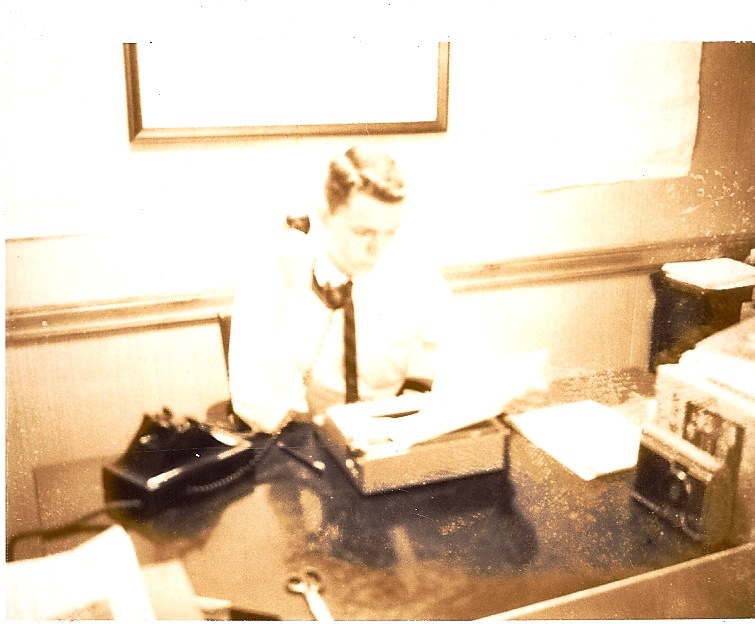 |
 |
During sophomore year the girls get some sun after swimming over at Dravo Pool. Center, Eleanor (white suit), rear Marilyn, and right (black suit) Joyce. To swim at Dravo you had to be related to someone who worked there, or know someone related. Once you had a pass, you could take guests. We would either ride the bus or pedal our bikes over. It was a great facility. There was a snack bar, dressing rooms, picnic grounds and plenty of room to spread out on a towel or blanket, as is shown here. |
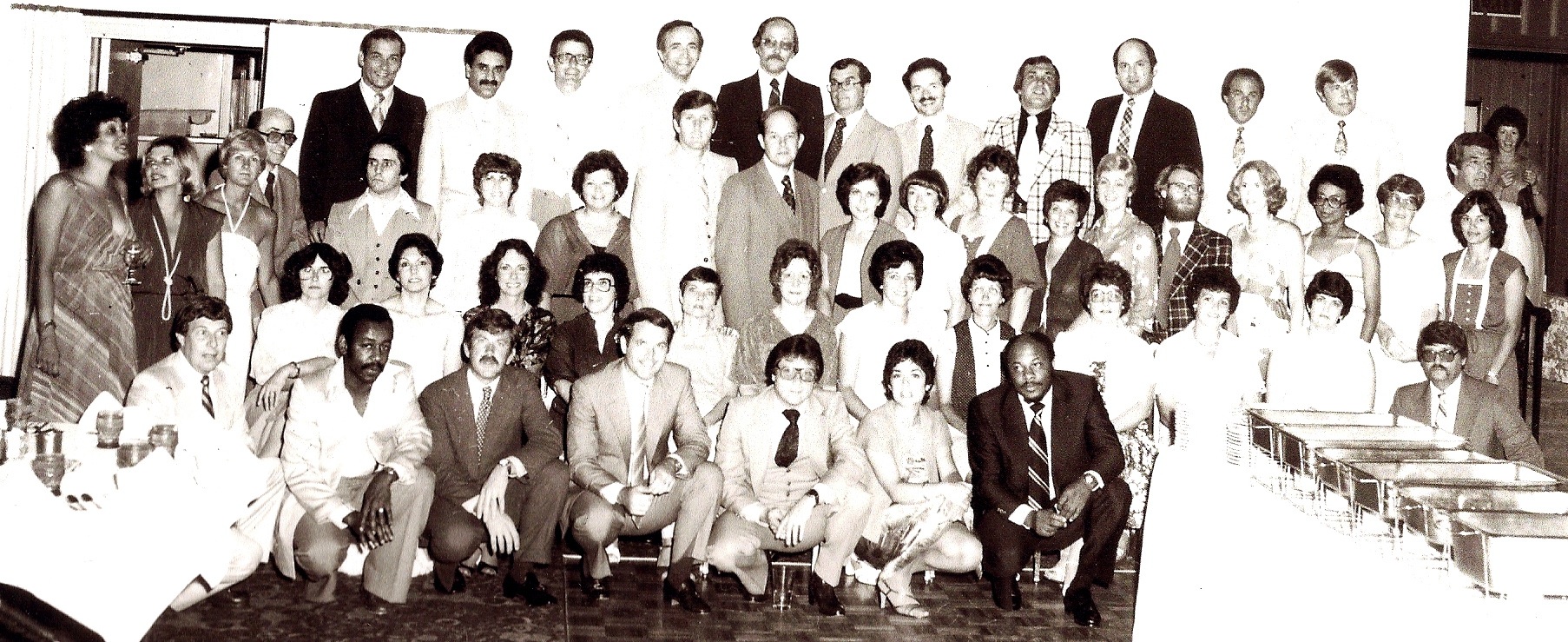 |
| Our July 1980 20th Year Reunion. (L to R) : front : xxx, Alex, GeorgeE, Jim, xxx, Lucy, GeorgeR. second : Leona, Rose, Marilyn, Rita, Linda, Eleanor, Lou Ann, Mary Ann, Janet, Marge, Janice, xxx. third : Harriet, Carolyn, Jan, Al, Don, Judy, Dorothy, xxx, Tony, Marianne, Gloria, xxx, Elaine, Joyce, Bob, Michaele, Shirley, Barbara, Grace. fourth : Ross, Louie, DaveL, BobSch, xxx, xxx, BobC, Jesse, BillN, Ron, Stan, Ange. |
| In l943, wanting to "provide wholesome opportunities for socialization, give our students an alternative to negative behavior, and teach etiquette and social skills such as dancing," Harry Houtz tried to convince the Coraopolis Board of Education to host weekly dances. They refused. So he took the idea to the YMCA, which agreed to set up a student run organization as long as parents attended and supervised each event. Thus was born the Saturday Night Club. 17 years later, during our senior year, the club held an anniversary dance to celebrate its longevity. Officers during our senior year were from left Dorothy, chairman of Food & Corsages; Judy, president; Grace, treasurer; Gloria, secretary; and Judy L, chairman of decorations and theming. Although Herbert Snell patterned his Friday Night Club after Houtz's older version, since we experienced the Friday Night Club first, and it was where we all learned to dance, it seemed like the more important. But the Saturday Night Club hosted weekly dances all year round, even in the Summer. Some were informal, but several special semiformal dances were held each year. When our own children were in high school, we regretted that they did not have the same experiences. The Saturday Night Club lasted until the school systems merged. | 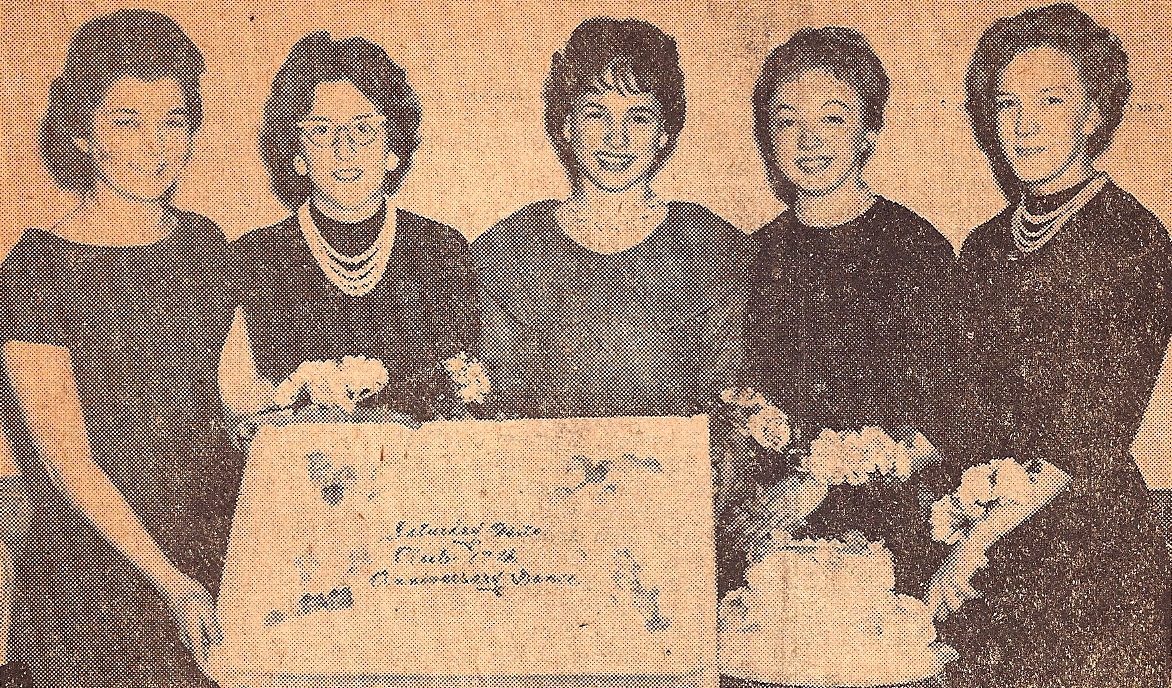 |
 |
The results of their labor can be seen at left. This is the annual Snowball Dance, held in January. Like most of the semiformal dances, it featured a live band. The money from paid admissions each week had to be carefully managed to afford to bring in live bands and disc jockeys on occasions. Even though the name said Saturday Night Club there were a few occasions each year when dances would be held after home games on Friday nights. The photo below of the girls kneeling on the school steps shows, front from left, Lynn, Leona, Honey, Olive and Rose. In the back, from left, are Harriett, Cookie, Barb and Ida. Below left are from left Leona, Lynette and Rose. Below right are Barbara and Georgia.
|
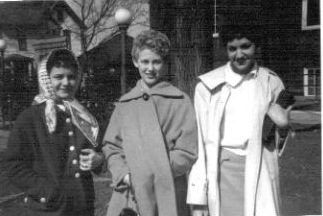 |
 |
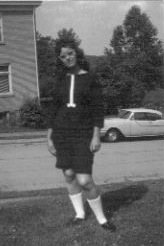 |
 |
| This is a great shot looking down State Avenue toward town from the high school. On the right is the Ferguson Ferree home, with the Baptist Church rising behind it. On the left is that row of 19th century homes sitting up on the bank. Sweterlisch's would be directly across the street to the left, out of this photo. Pay particular attention to the old cars parked along the curb and the one approaching us. | 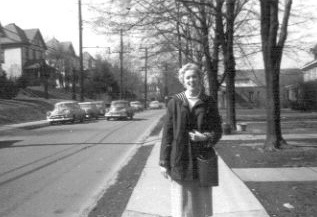 |
 |
One of the annual traditions in Coraopolis was the Easter Parade. That was the display of new clothes the girls showed off on Palm Sunday, Black Friday and Easter Sunday. Shopping for new clothes usually meant a trip into Pittsburgh to Kaufman's, Gimbel's and Horne's with their mothers. Of course, those clothes had to be shown off. So after church on Sunday, visits to a grandmother, eating out at a restaurant, or perhaps a walk around the Greater Pittsburgh Airport were part of the tradition. Here, at left, Janet pauses after church. At right, Lynette and Janet show a little leg, since the fashions of the day certainly didn't show much. | 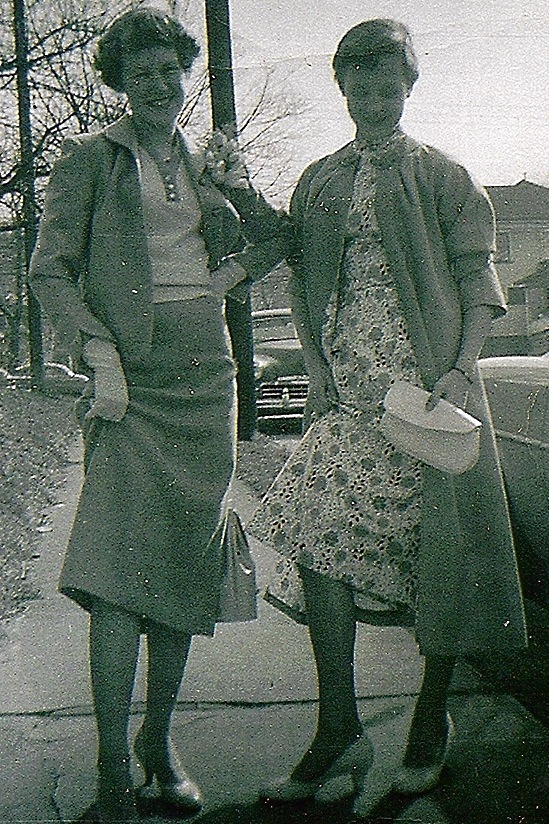 |
 |
Our very own version of Sophia Loren --- actually it's Grace --- stretches seductively on a Saturday morning after a hard partying Friday night. Notice the close cropped hair, about the closest thing a girl could come to a crewcut. |
| Although they were a year ahead of us, the Riker Twins (Ruth and Roberta) were close friends with many of our classmates. After they graduated, the twins moved to Erie, but came back to visit frequently. Here, they pose with Gloria (left) and Grace. | 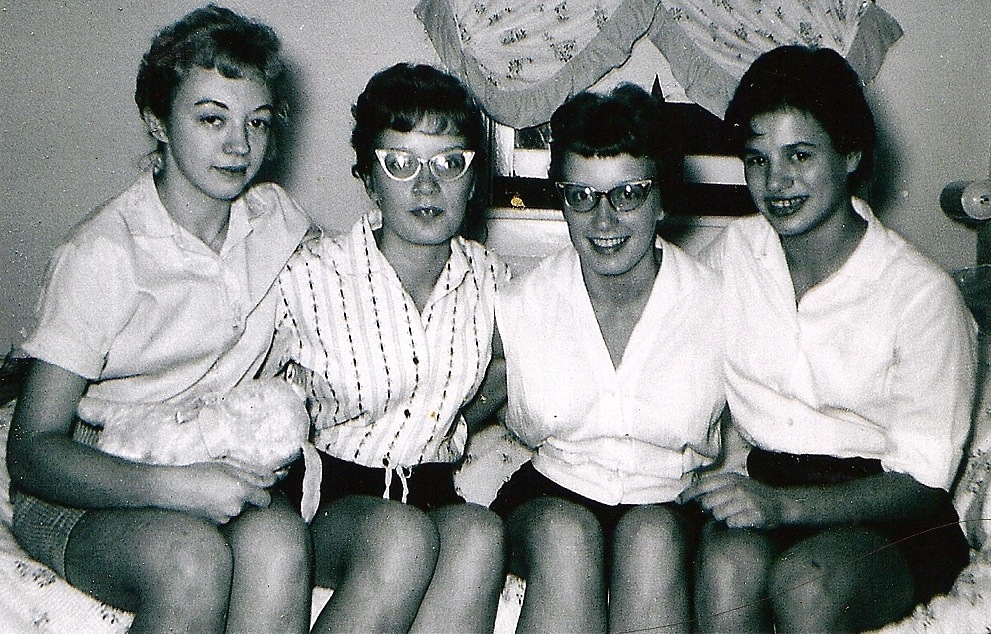 |
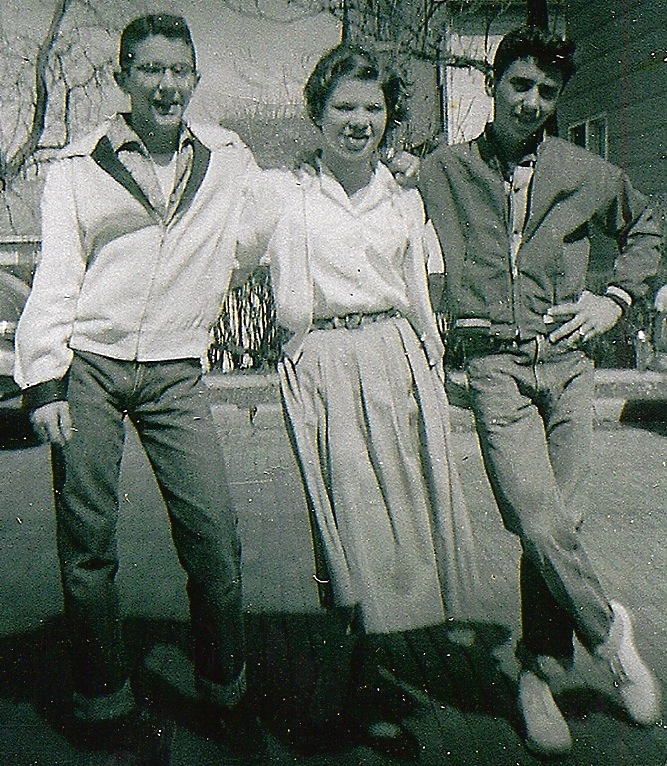 |
It looks like a scene from Grease, but this is just David (left), Carolyn and Louie. Notice Louie's white bucks and both boys' rolled up pant legs. |
 |
Our girls made an art form out of weekend Slumber Parties. At left, Gloria and Honey watch late night television while Grace tries to get drunk on her one bottle of Pabst Blue Ribbon. At right, Lucy and Elaine pitch camp on the floor while Gloria (left) stretches out on the couch. |  |
| Lucy (left), Janice and Grace pause on the way home from school in March of our senior year. Notice all three girls wearing saddle shoes and bobbysox, the length of the skirts, and Janice's GAA letter jacket. | 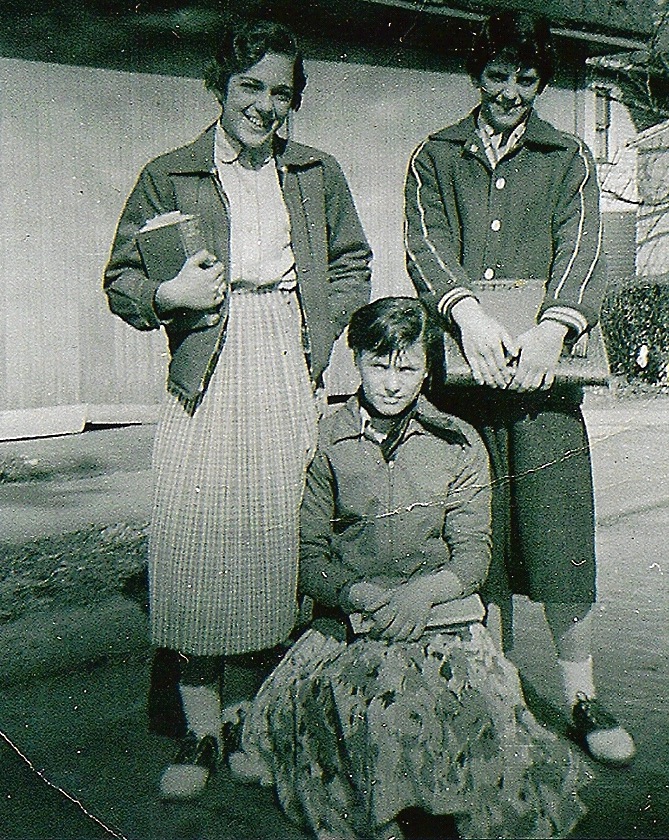 |
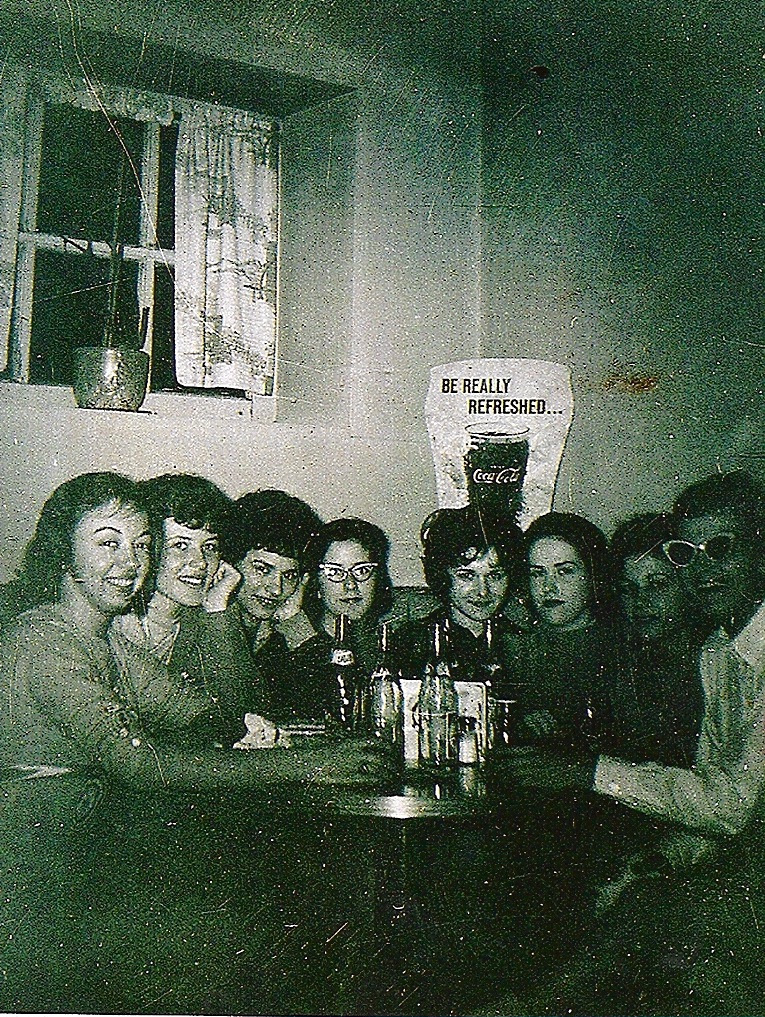 |
After each Saturday night dance, stopping by one of the local restaurants was a favorite activity. We had several places serving Pizza, which in the 1950s was the big new fad. National pizza chains did not yet exist, so any restaurant serving pizza was making its own, and we had several restaurants making very good versions. Here, at left is Gloria, at the back are Grace and Judy, and showing off her shades at right is Janet. |
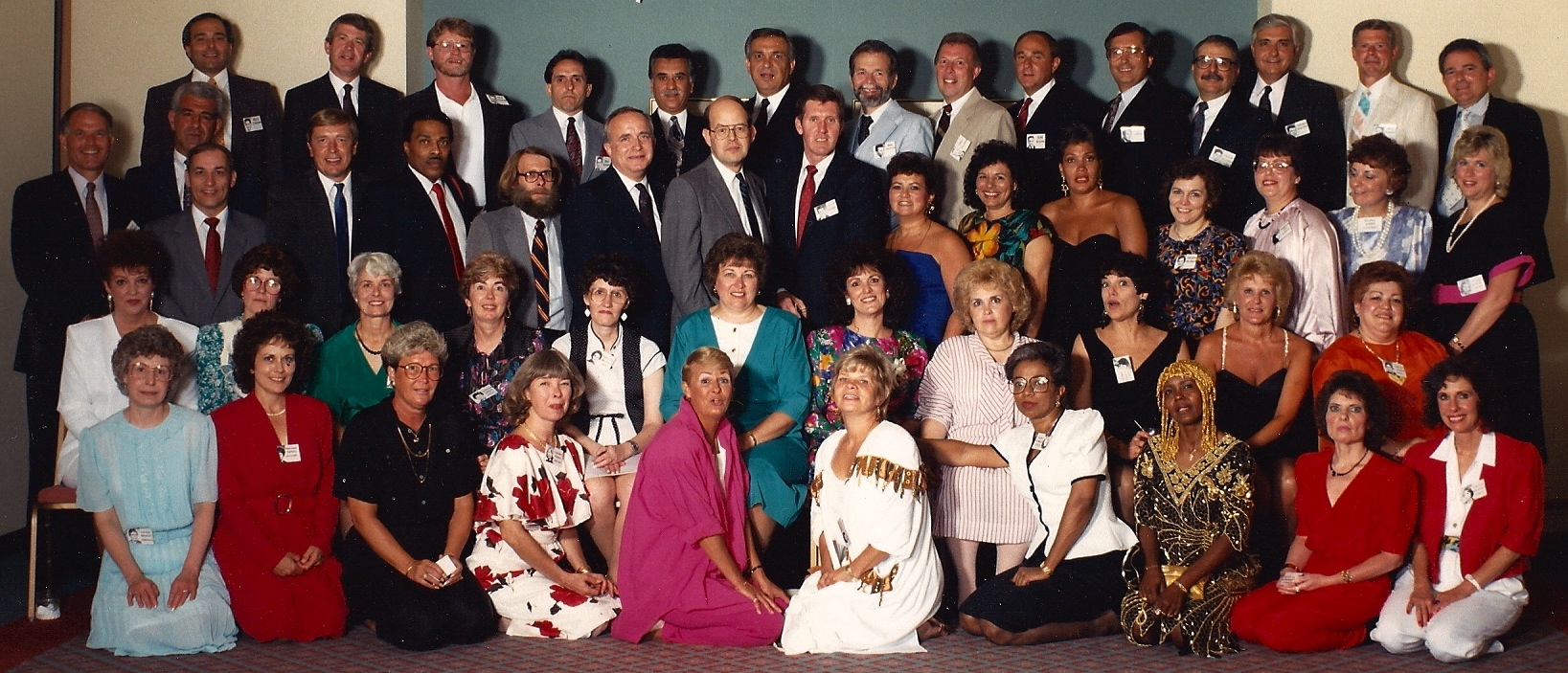 |
| Our July 1990 30th Year Reunion. Seated (L toR) : Eleanor, Marianne, Barbara, Margaret, Janet, Carolyn, Shirley, Blanche, Linda, Marilyn. Second Row : Sharon, Leona, Carol, Charlene, Mary Ann, Lou Ann, Margie, Rita, Lucy, Honey, Harriet. Third Row : Jim, Angelo, Ross, Stan, Tom, Bobby, Bob, Anthony, Ken, Dorothy, Grace, Harriet, Jacquie, Roberta, Donna, Michaele. Fourth Row : Pete, George, Dave, Don, Louis, Paul, Bob, Dave, Ron, Jesse, Frank, Dominic, Bill, Dave. |
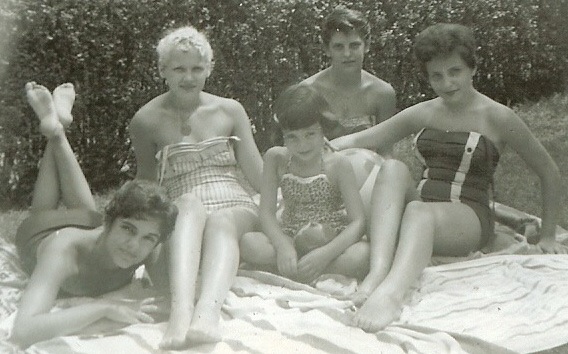 |
 |
| One of our class's finest achievements received surprisingly little attention at school even though it involved a school activity. During the Summer betwen our sophomore and junior years Carol was elected National President of the Future Homemakers of America. By 2000 FHA had become coed and been renamed FCCLA, but back in the fifties it was one of the nation's premier teenage organizations, on a par with the Scouts and Four H. Carol had first become interested in the range of domestic skills as a Girl Scout. Carolyn remembers how frustrated she would get with her close friend and neighbor. "We'd have a project and I'd work really hard and do a good job and be real proud and then we'd show up at meetings and Carol's project would just blow the rest of us away," she recalls. "We were in Scouts several years and none of us could compete with her." By junior high, Carol had transferred most of her focus to FHA, and by ninth grade had begun to climb the ladder of rank and politics. She earned Junior, Chapter and State Homemaking degrees and first drew widespread attention with a strong showing at the State Farm Show in ninth grade, then returned a year later to win the Sewing competition. She had been elected Vice President of the Pennsylvania FHA and was on schedule to perhaps become president of the state her junior year and make a run at national office her senior year. But like any other political arena, there is always a certain fluid nature to campaigns and elections and people emerge before expected. The outgoing Pennsylvania president nominated Carol and after a quick and intense campaign she won. So at the age of 15, Carol spent much of our junior year travelling, speaking and working on behalf of the FHA. To make room for this in her schedule she postponed taking Chemistry until her senior year and backed off several other activities. Carol would go on to major in Home Economics at Carnegie Tech where she would participate in several sports, student congress, student court, and, of course, the Home Ec Club. |  |
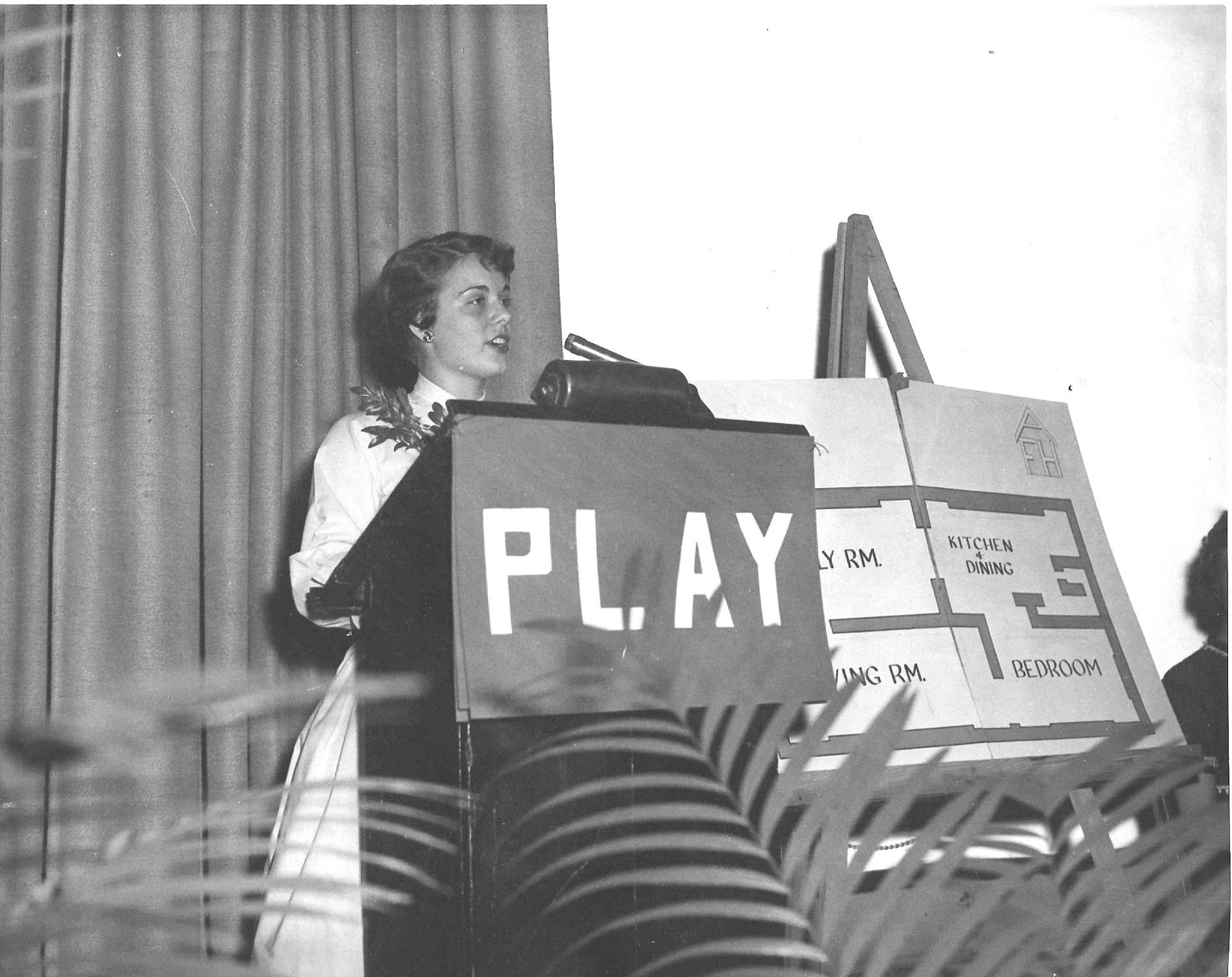 |
Carol is shown here at left accepting the national presidency in a speech to the assembly at the convention in Kansas City, Missouri. She would teach Home Economics briefly at Montour High School before moving on to Colorado and back to Philadelphia. She and her husband are now retired and living in Vermont, where she is a competitive skiier on the NASTAR Circuit. |
 |
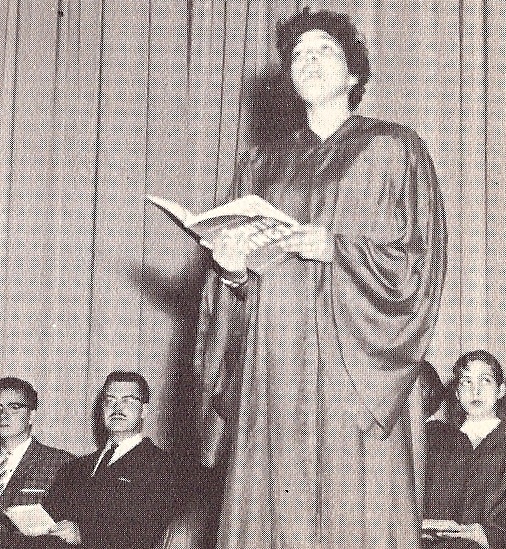 |
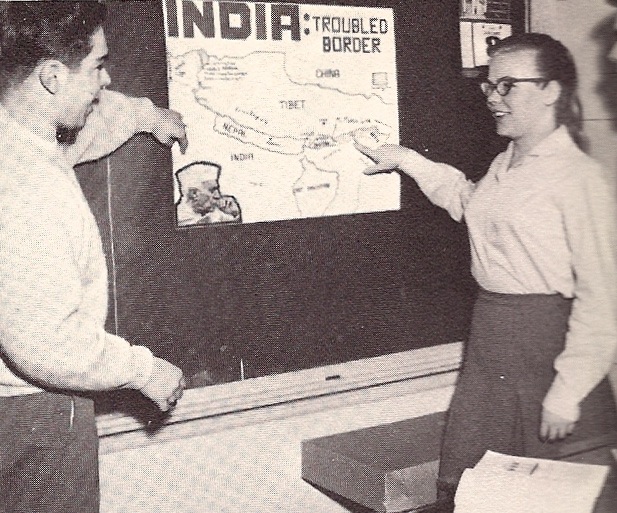 |
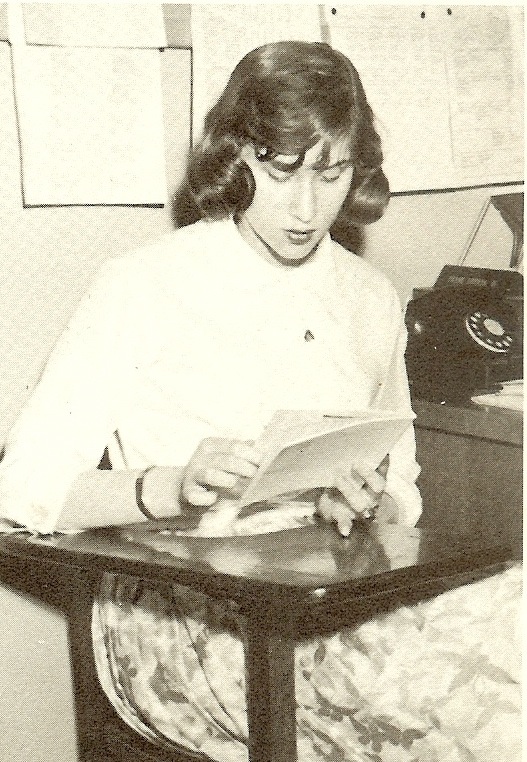 |
Most of us took the American College Test and Scholastic Aptitude Test so we could forward our scores to college as part of the admission process. Coraopolis had given us a good education and most of our scores were high. But none so high as Michaele Snyder's. She attained the highest score in Allegheny County and special recognition in June 1960. |
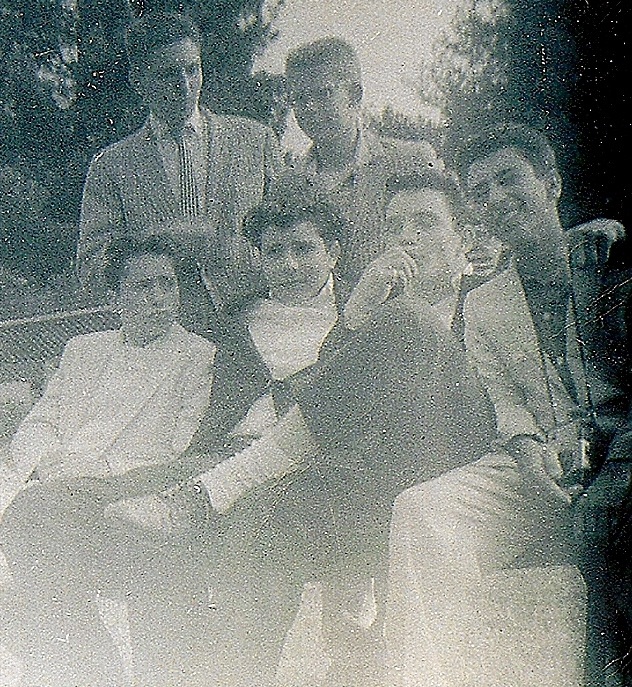 |
As Lucy would say, "Delinquents All." At left, bottom, are Jesse, Dom, Nick and Louie. Top are Paul and Bobby. At right, at left in pensive pose is Marianne (possibly praying for the others). Then there's Big Ange, Nick, Lucy, Janet and Lynette. | 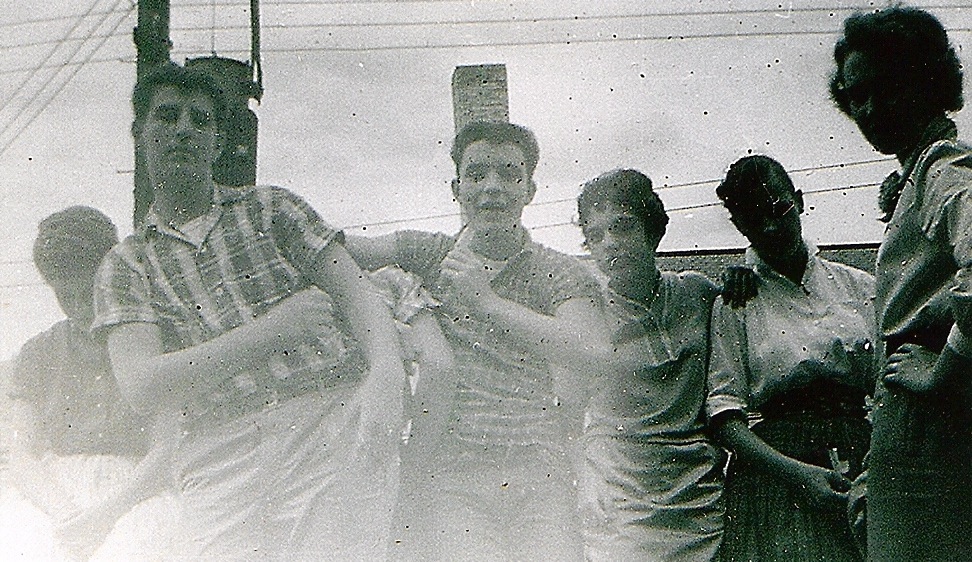 |
| One of our elective classes which almost everybody took was Lillian Griffith's Public Speaking course. All year we gave speeches of various types. Here is Bob at the podium. As outspoken and lively as most of us were, it was interesting to see how many had difficulty delivering a structured speech to an audience of their peers. But we spoke on all sorts of topics and learned from each other. We heard speeches on Playing The Line In Football, Souping Up A Car, The Ecology Of McCabe's Creek, How To Bake A Cake and The History of the Coraopolis Fire Department. | 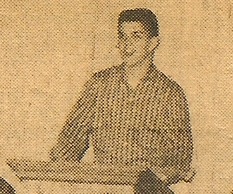 |
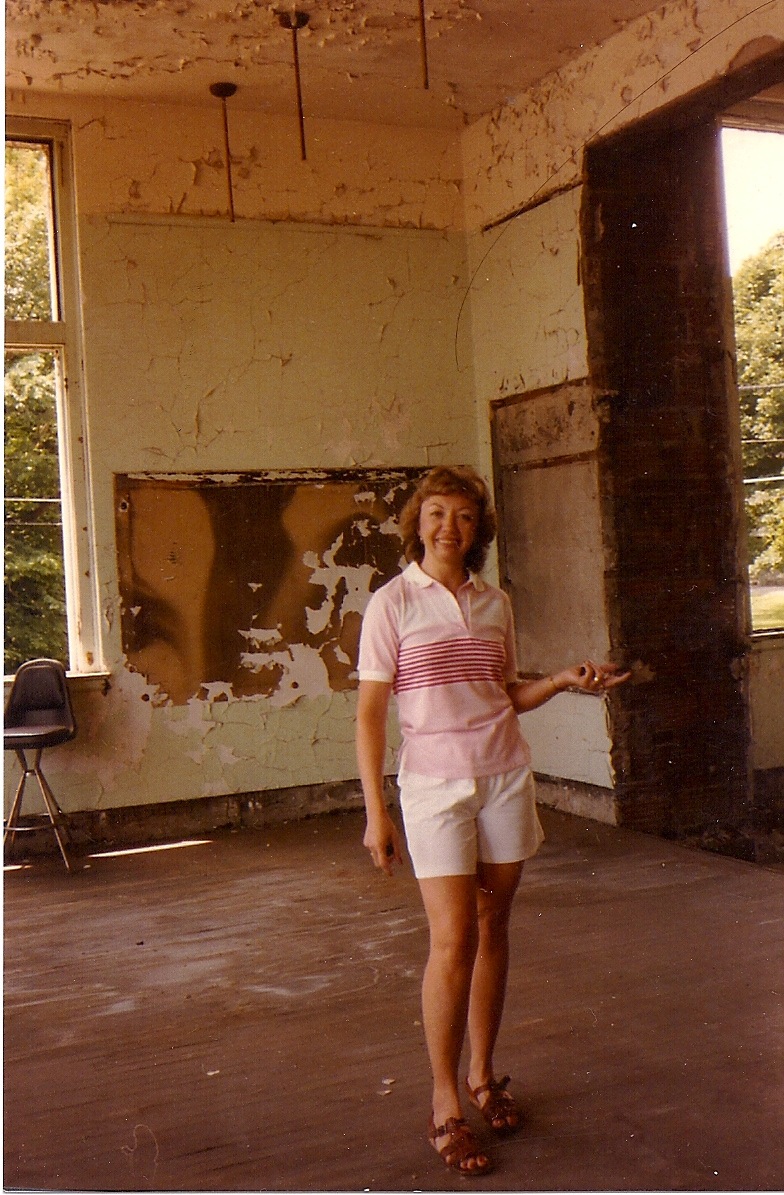 |
For as cool and detached as we tried to be while we were in school, after we graduated and were gone for a few years we became surprisingly attached to the town and its schools. When Coraopolis was merged and sold off the buildings, those of us still living here or back for a visit took matters into our own hands. We learned when the wreckers and salvagers would arrive and either just ahead of them or in between their work sessions, we snuk into the buildings and saved what we could. Some of those rescues involved old desks or clocks. Some saved the huge framed paintings that hung in the halls or classrooms. In one famous (infamous) raid, a group hijacked one of the elementary bells in the middle of the night. Here, Gloria stands in Isabella Pfingstl's classroom. It has been totally stripped and all furniture, flooring, ceiling lights, even the blackboards, removed. There wasn't much left for Gloria to rescue, so she pried a brick loose from the corner of the building and took it home. For 37 years she has treasured her one brick. Who knew the place meant so much to us? |
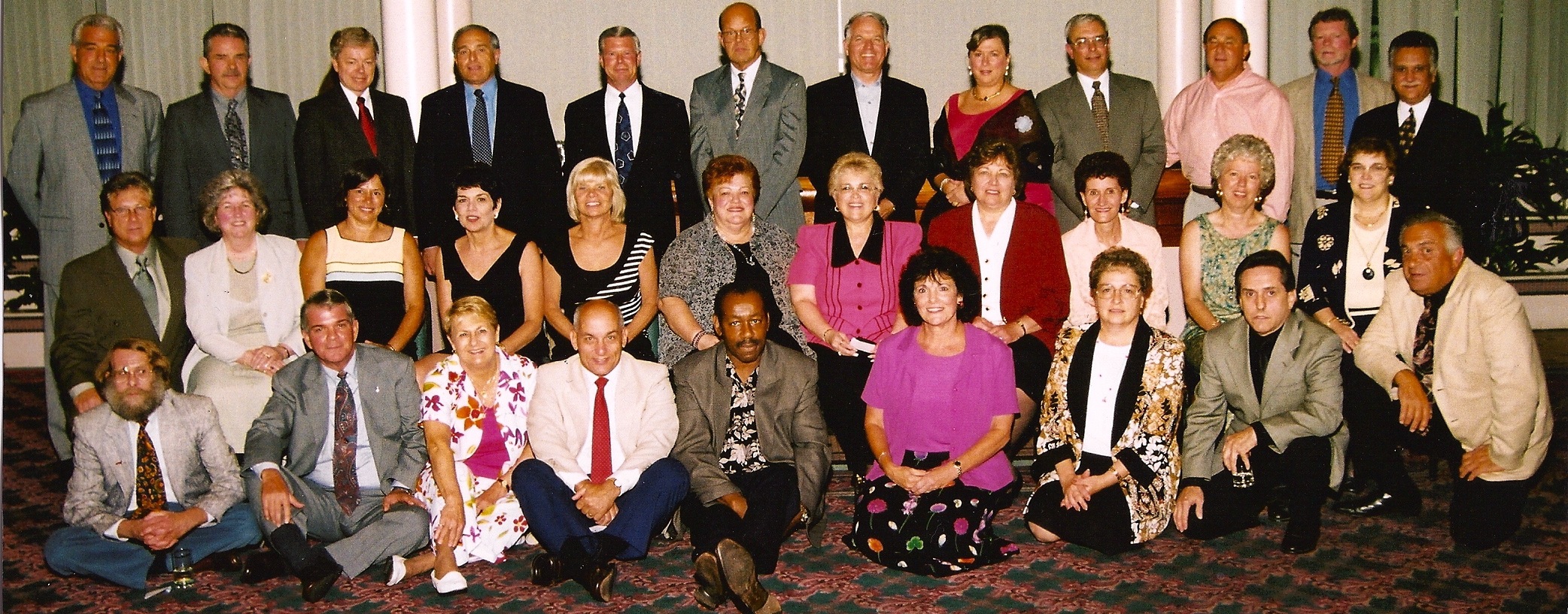 |
Our July 2000 40th Year Reunion. Seated (L to R) : Bobby, Bob, Janet, Ross, Alex, Margie, xxx, Don, xxx. Second row xxx, xxx, Grace, Lucy, Carolyn, Harriet, xxx, Barbara, Charlene, Kathryn, xxx. Third row Ange, xxx, Danny, Pete, Bill C, Tony, xxx, Michaele, David H, Ronnie, Dave D, Louie. |
In February of our senior year, BillR received his Eagle Scout award at a ceremony at the Presbyterian Church. He is shown here with his mother. Back in the fifties, Scouting was a more prominent activity than it is now, and the Eagle rank was extremely hard to achieve. The two biggest hurdles were the Swimming and Lifesaving merit badges, which many of us suspected were made unnecessarily difficult just to weed out the less determined. Because some of the merit badges were prerequisite to others, it usually took a boy until age 17 or 18 to finish the requirements, and often time ran out, because it had to be completed by age 18. In our class, John and Danny also earned this rank. Bill went on to a career in Scouting Administration and won several adult awards. Three of his fellow scouts from Troop 133 would go on to serve as Scoutmasters elsewhere and five would go on to careers in Outdoor Education, Widllife Biology or the Depart- ment of the Interior. |
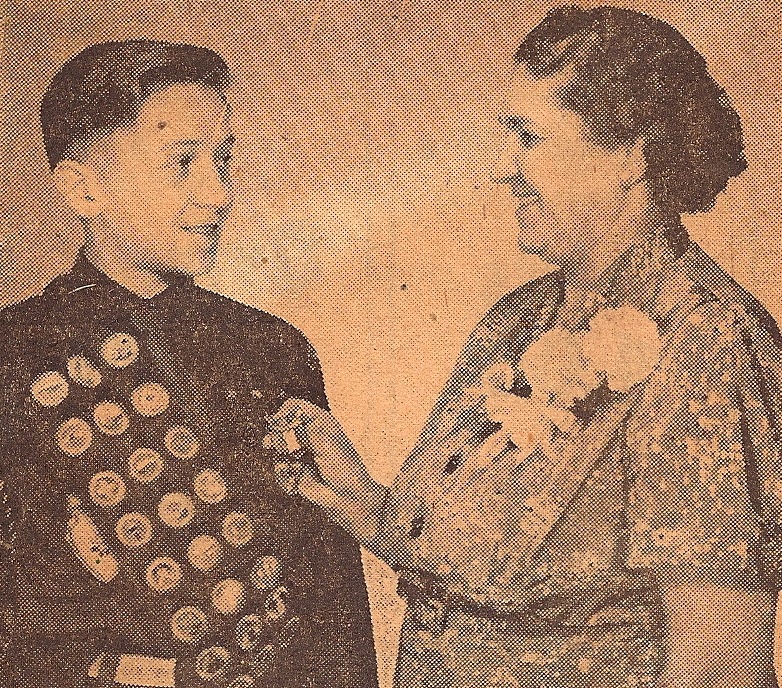 |
 |
For a high school with no formal drama program, we sure got up on stage a lot. We put on full scale plays, concerts, variety shows and the annual Operetta. Council Capers was always one of the highlights of the year. It offered everything from instrumentals to vocals to highly trained dance troupes, like the one at left. |
Carol finished off her high school career in spectacular fashion, being named to represent Pennsylvania at the White House Conference on Children and Youth. Then, in May of our senior year, she was named Pennsylvania Girl Of The Year by the Pennsylvania Federation of Women's Clubs.
|
 |
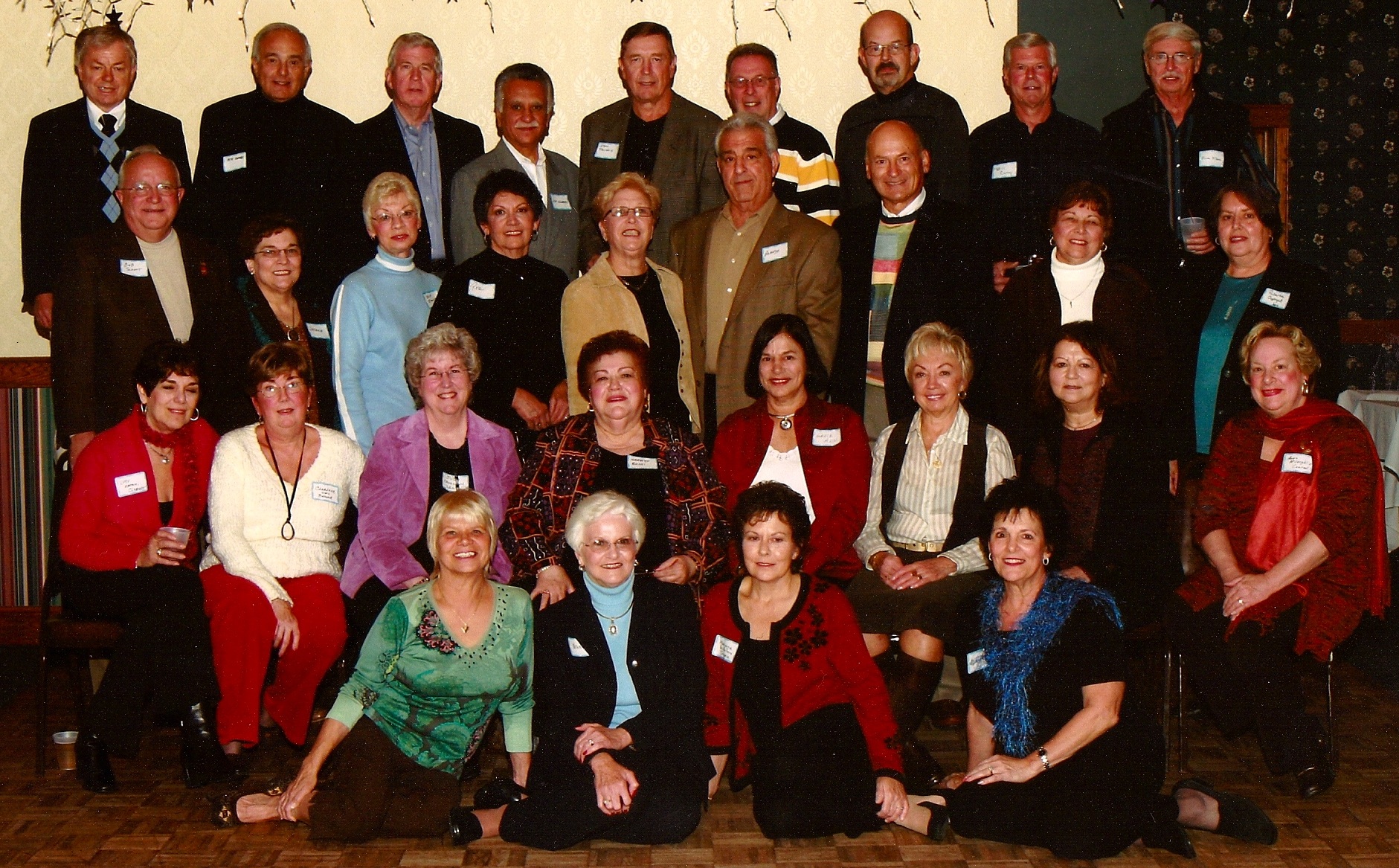 |
| Our October 2006 46 Year Reunion. Seated (L to R) : Carolyn, Nancy, Marianne, Margie. Second Row : Lucy, Charlene, Judy, Harriet, Grace, Gloria, Dorothy, Ann. Third Row : Bob, Jacquie, Ida, Rose, Barbara, Angelo, Bill, Lou Ann, Roberta. Fourth Row : Danny, Pete, George, Louie, Stan, Dave, Tony, Bill, Jay (Buzz). |
| BillR and Margaret admire their trophies after placing second in the entire state in Future Business Leaders of American competition. | 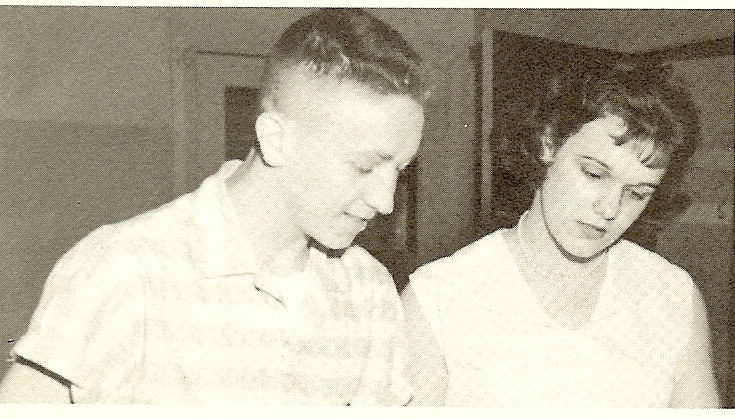 |
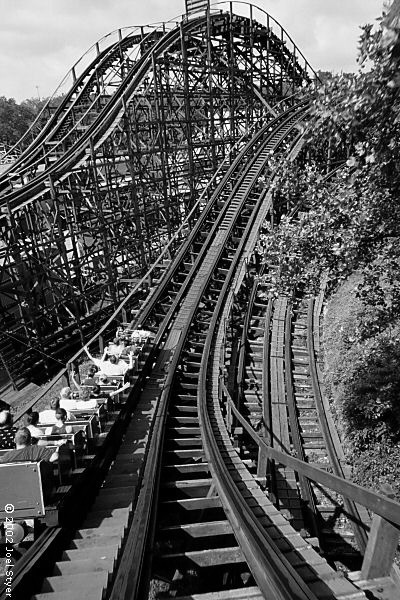 |
We continued to finish each school year with the Kennywood Picnic. For several years we had all been intrigued by The Racers. There were two trains on parallel tracks. Nowhere along the ride did the tracks cross. But if you got on the blue train in the right hand lane, you returned to the platform in the left hand lane. On each ride, the red and blue trains switched places. We rode this ride over and over, walked all around it, and could not figure out how this worked. Finally, in Geometry class, Miss Malter explained it to us and diagrammed it on the board. It was a Mobius Loop. The mathematical phenomenon had been discovered early in the century and John Miller incorporated it into the Racers' design. We all had to try our skills at the rifle gallery, skee ball and baseball toss. The Penny Arcade had lots of arcade games, a fortune teller, The Giant Claw, and even a photo booth, each for a penny. In the evening we could grab a seat at the Band Shell and see Spike Jones and the City Slickers, Bill Haley and the Comets, The Everly Brothers, Frankie Avalon, Buddy Holly and Bobby Darin. Those of us in the band got to go to Kennywood a second time every year. The band always took part in the Fall Festival, an August parade through the park. After the parade, we got to spend the evening on the rides. It was great, but didn't match the school picnic. It was hard to enjoy a ride in a band uniform. |
For our sophomore year, Kennywood added The Rotor, a huge cylinder. We stepped inside, lined up along the wall, and as the ride began to rotate, the floor dropped out. We were all stuck to the wall like flies. For three minutes we got to crawl around in defiance of gravity. Then the ride would slow down and we'd all drop or slide to the floor, which slowly rose to meet us. Shown here stuck firmly to the wall in the white sweater is our foreign exchange student, Annie Bergvist. |
 |
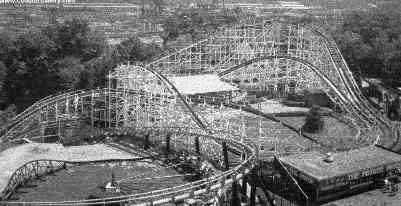 |
Being Big Kids now, we could all ride The Pippin (left). John Miller did this coaster at the end of his career. He threw every trick he knew into it as his grand finale. Using the Upstop technology, he sent the trains straight down the cliff, not once but four times. He sent them around "The Spaghetti Bowl" twice at breakneck speeds to place the riders under lateral G forces. And, rather than a long beginning lift hill, he dropped the trains down the cliff right out of the station. It was a wild, hairy experience and we couldn't get enough of it. Long before we could drive, this was our speed high. As we got old enough to drive, some of us would go back to Kennywood for an evening of miniature golf or a concert in the band shell. But nothing beat the school picnic. And we took special pride in hearing friends from Moon, Neville and Montour complain about not getting to go to Kennywood. They had to go to West View, its poor cousin. |
| For a lot of classmates, Kennywood was still about the big swimming pool. The largest in Pennsylvania, it was a great place to people watch, ride the slide, or float around under the fountain. They even had a sand beach. The beach and pool were always crowded but a lot of fun, especially on a hot, humid day. For most of us, whose pool experiences were limited to Dravo, Windwood and the Y, the Kennywood pool was immense. It took 20 minutes just to walk around it. |  |
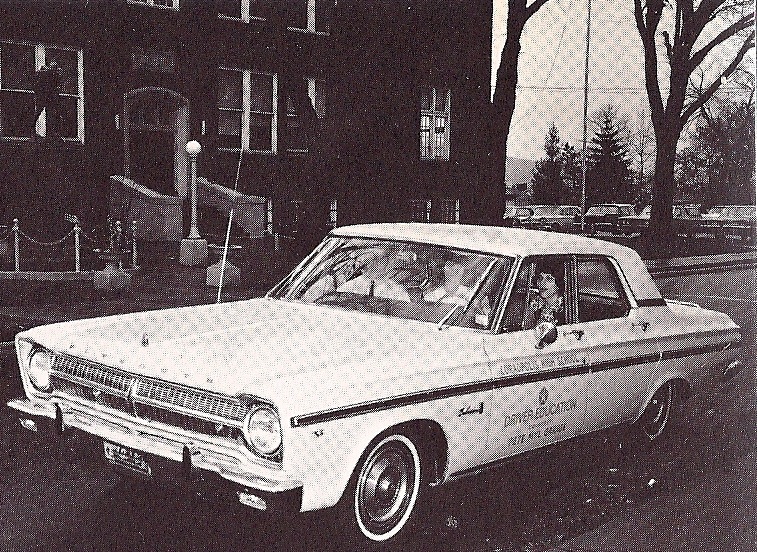 |
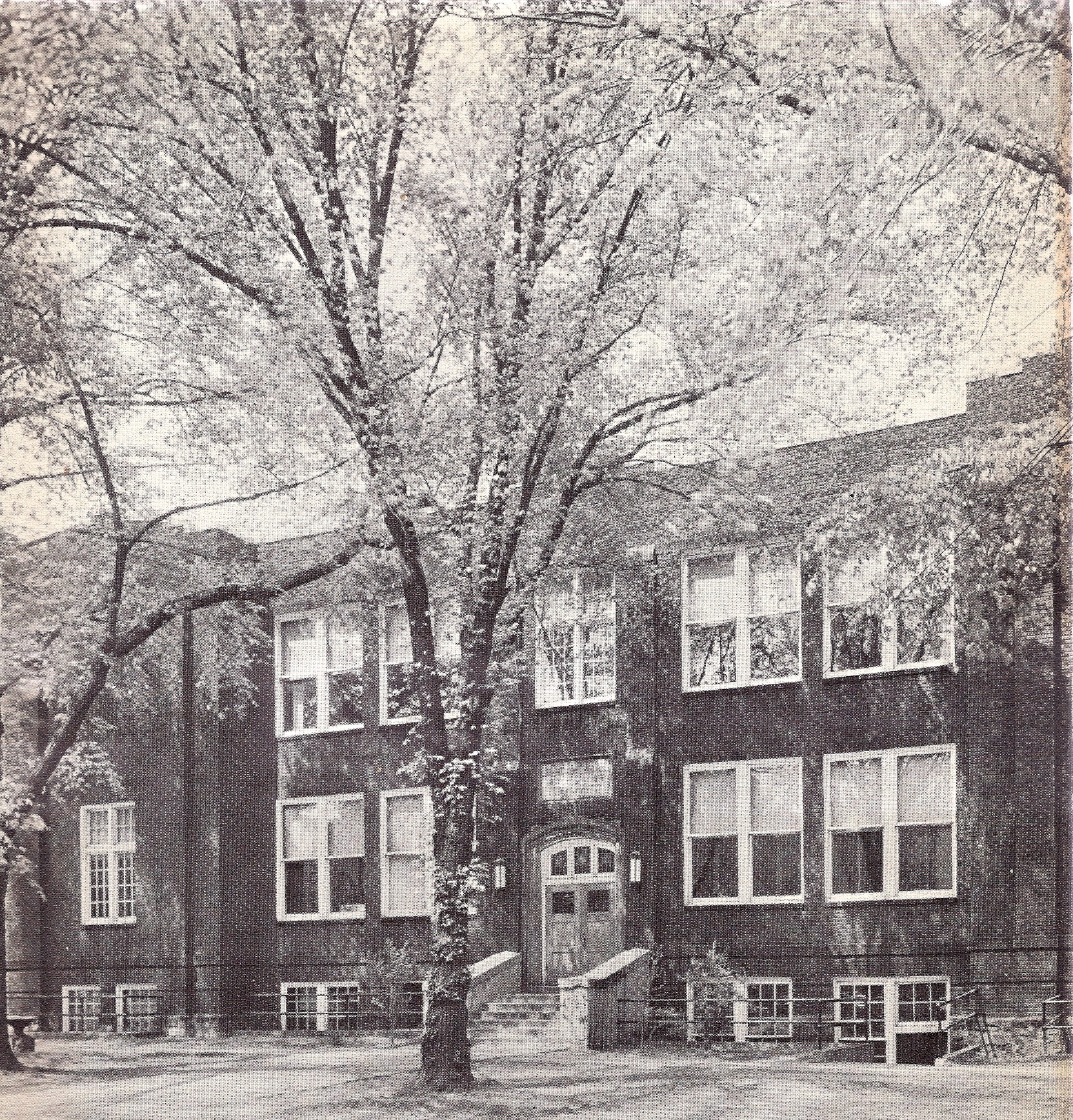 |
 |
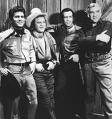 |
As our senior year began, our favorite tv shows were The Untouchables, Twilight Zone, Rawhide and Bonanza. The Untouchables started our junior year. It dealt with Elliott Ness and the government's attempt to rid Chicago of Al Capone. Most parents, teachers and the Coraopolis Church Council were highly critical of the show because it was by far the most violent ever seen on tv. Bonanza and Rawhide both had catchy music and hour long episodes and refined the Western to a new level. Rod Serling's Twilight Zone was a weekly science fantasy the twisted our minds and gave us something to talk about the next day in school. Some of our families had color by 1959 and the shows were all broadcast in color, but many homes still had black and white. With rototennaes many homes had added Johnstown, Youngstown and Steubenville to their channels. | 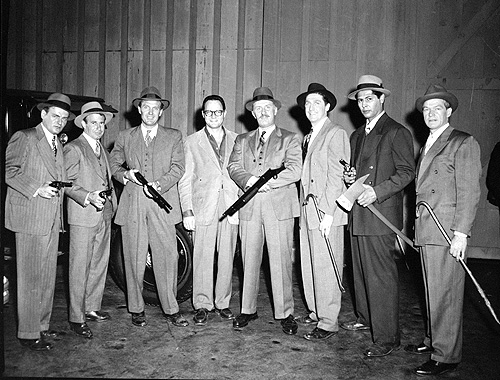 |
 |
One thing boys never worried about was makeup. Girls did. Here, Carolyn (left), Gloria (back) and Janice remove makeup during lunch time at Gloria's house, presumably so they can reapply it before heading back to school for the afternoon session. Unlike girls today, who have adopted a "grunge" look, our girls back in the late 1950s invested a tremendous amount of time in their appearance all day every day. |
 |
As we entered high school the car culture was exploding. Boys read Hot Rod and Street Rod and dreamed of owning their own cars. Reigning over this fantasy world was senior Dominic Santucci. His cherry red 1940 Ford Coupe was the hottest car in the county. He had rebuilt it himself from the ground up with a '53 Olds V-8 engine. He parked across the street from the school. Every afternoon a crowd gathered just to hear him start it. Once a week or so someone from another town would show up to challenge him to a drag race on the long Neville straight. He never lost. |  |
David was one of our more inspirational classmates. Blind from birth, he insisted on doing everything everybody else did. He had a silent braille typewriter which he pecked away at during classes. Nick would hang his cane from the overhead pipes as a prank. At first teachers would apologize to his mother, but she would wave it off. If we were so uncomfortable around him that we did not treat him like everybody else she said she would worry. The fact that we played tricks on him meant we accepted him as one of us, which she wanted. But David was not defenseless. He would sprinkle salt in Nick's soft drinks, pepper on his french fries. Over the years David had overcompensated in other ways for his blindness. He could sit on his front porch and tell the kind of car driving by from the sounds it made. One of the more interesting aspects of life with David was his music. He played a special instrument called the Theramin. As you will recall from the photo at right, it had a long metal rod extending vertically and a second one extending horizontally. Moving hands back and forth along the rods and closer or further from them, he could control the notes, tone, pitch, and volume. As we all learned, the Theramin is the instrument used in scary movies to play those eerie musical strains. At concerts and talent shows David would play his Theramin. We found it quite weird but one of the highlights of the show. David went to Thiel College and majored in Physics. Along the way he became fluent in nine languages, but he would graduate with honors in science and go on to Pitt, where he earned a masters and doctorate in Physics. He has spent most of his career researching Acoustics as it relates to music and sound systems. |
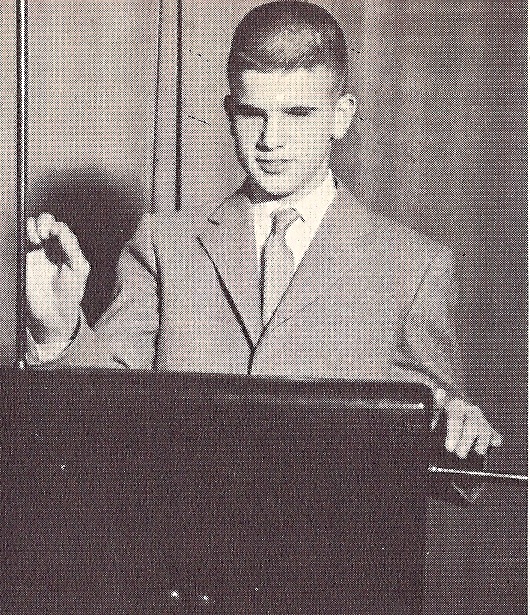 |
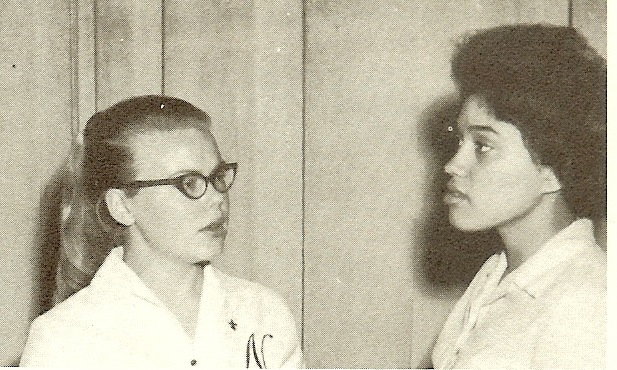 |
Annie Berqvist, who was a foreign exchange student to Coraopolis, talks with our own foreign exchange representative, Harriet. Harriet went on to quite a career. Graduating from Juniata College, she would work her way up through various business positions until becoming President of the National Minority Development Council, a private nonprofit organization that expands business opportunities for minority owned company owners. She also serves on the board of Juniata College and Triad Hospitals, and has held positions on 13 other councils and boards. She was awarded an honorary degree from New York's Baruch College, is in the Minority Business Hall of Fame, and has spoken at Harvard, Princeton, the University of California and University of Florida. |
By the time we got to high school, Rock n Roll was in full bloom, the clarinet, trumpet, and sax had been replaced by the guitar as America's favorite instrument. and we had a long list of vocalists for the girls to fantasize about and the guys to try and imitate. There was Bobby Darin, Frankie Avalon, Ricky Nelson, the Everly Brothers, and some guy from Tupelo, Mississippi, trying to mix black gospel music with white rock. There were also black singers like Nat King Cole and Johnny Mathis. But it was a skinny glass clad white kid from Lubbock, Texas born Charles Hardin Holly who took over the decade. He had started out as the opening act for Bill Haley and the Comets, then for Elvis during his rhythmn and blues phase, drawing upon both and adding his own innovations. We weren't musical theorists or historians. We didn't understand how he was pioneering the use of sharps and flats, establishing techniques the Beatles, Rolling Stones, Bob Dylan and Beach Boys would use a decade later. We didn't know he was inventing whole new guitar chords, paving the way for the instrument to continue its rise to dominance. All we knew was that when Buddy Holly sang Peggy Sue, Rave On, Oh Boy, and That'll Be The Day he was somehow bringing together all the various elements of rock n roll, synthesizing them into what the new music had been trying to become. What we somehow sensed and had confirmed later was that the others were being programmed, managed, packaged. Their music was Corporate Pop. Holly left Nashville because they would not let him perform what way he wanted. We wouldn't know until we graduated from college that critic Bruce Eder, considered the chronicler of 20th Century music, considered Holly the most influential musical innovator in American history. Bob Dylan said Holly didn't create rock n roll; he merely perfected it. When we went to see Holly perform in the Kennywood Band Shell it was a pilgrimage. When Buddy Holly died in a plane crash on February 3, 1959 it was one of the great traumas of our young lives. For a lot of us it was The Day The Music Died. |
 |
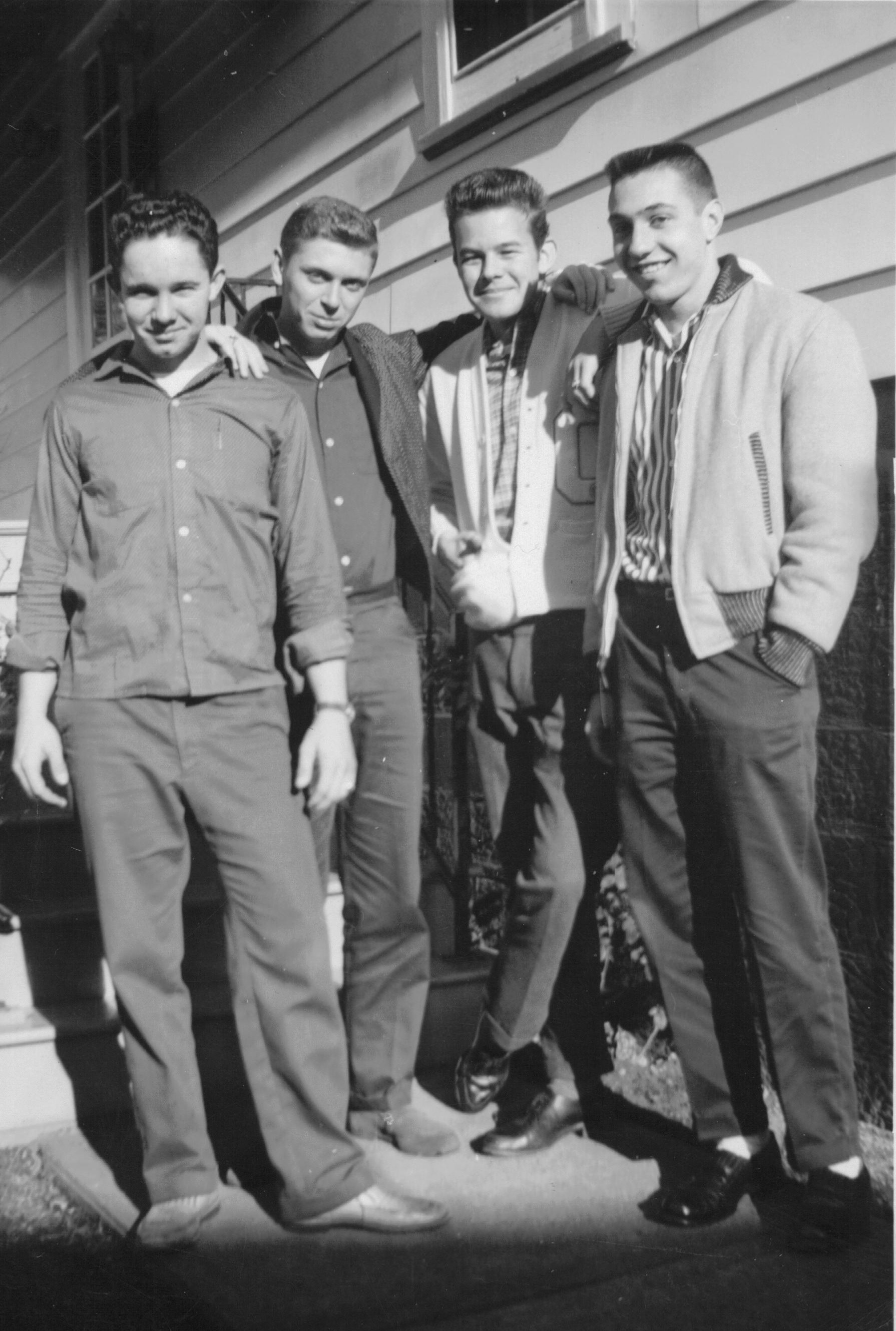 |
The officers of the Buddy Holly Fan Club pause on Neely Heights before a road trip to Kennywood Park to see Buddy Holly and The Crickets perform in the Concert Bowl. That's President BillP at left, who went on to earn a doctorate in plant pathology at the University of Vermont and has just retired as Supervisor of Tongass National Forest in Alaska. Vice President Buzz, second from left, majored in Public Administration and minored in Journalism at Penn State, spent most of his career as a reporter with the Johnstown Tribune Democrat, Outdoor Editor at Grit (a weekly national newspaper), and Outdoor Correspondent for the Associated Press, and is now retired living near State College, Pa. and fishing as often as possible, including trips to Alaska to fish with Bill. Secretary Tony, in the white letter sweater, spent most of his career on Neville Island before being transferred to Houston, and moving again to Tulsa before retiring in 2008. He has now moved back to Coraopolis. Treasurer Ken, at right, worked in the testing division for General Motors in Detroit. Ken is now retired and living in Highland, Michigan. |
Elaine was a key member of our class since 7th grade. She was an important officer in most of the clubs, was central to the planning of school events beginning with Friday Night Club and continuing through high school homecomings. She maintained one of the highest grade averages in the class for six years. In May 1960 she was named Coraopolis Girl of the Year by the Coraopolis Association of Business and Professional Women. |
 |
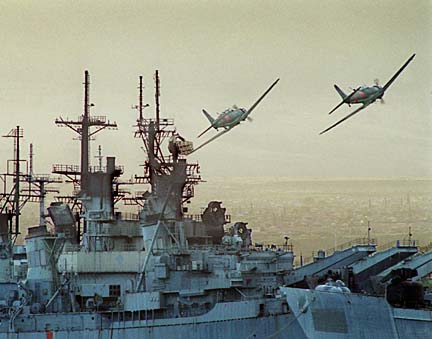 |
We were in high school in Hollywood's Golden Age. Never before or since has acting or direct-ing been as good. Almost every month or so a film now considered an all time classic came to the Fifth Avenue. We got to see From Here To Eternity (left), Picnic (right), Cat On A Hot Tin Roof, Ten Commandments, Stalag 17, Inherit the Wind, Battle Hymn of the Republic, Iron Lady, Magnificent Obsession, Run Silent Run Deep, Psycho, The Birds and a long list of other greats. Admission was 75 cents, a soft drink was a nickle and a bag of popcorn was a dime. | 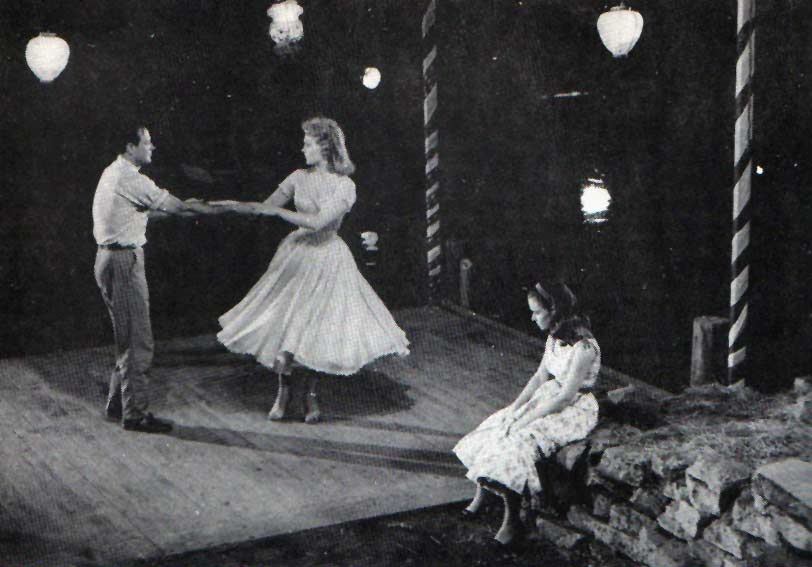 |
| The epic Big Country, still 50 years later considered the greatest Western ever made, was held over for three weeks to capacity crowds. It was considered an epic to rival Gone With The Wind. The Fifth Avenue had to close for a week and install a new Cinemascope screen and projector and Quadrasonic sound system to show it. The sound track was recorded by the Boston Symphony, was an immediate hit, and is still considered the greatest sound track in film history. Many of us walked around whistling strains from it for months. Burl Ives, Jean Simmons, Gregory Peck, Charles Buford and Charlton Heston won awards for their parts and William Wyler won director of the decade. We were all blown away by the screen and sound, which both wrapped across the front and up the sides of the theatre. If you sat in the lower third, it was as if you were IN the movie. Cinamescope was Hollywood's answer to tv. It got people back in theatres. | 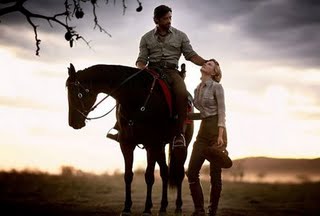 |
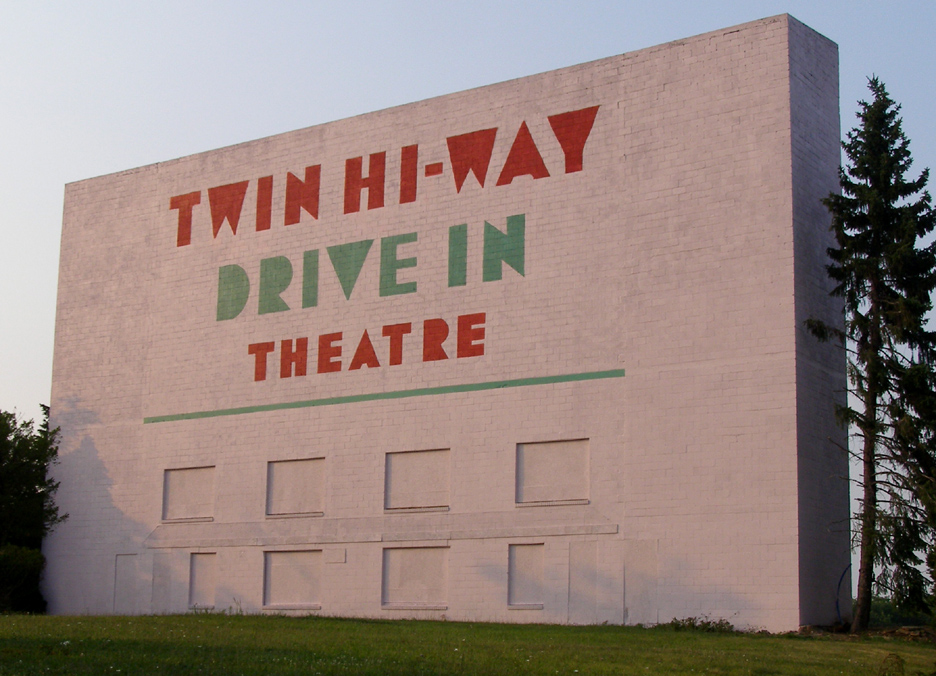 |
As we grew up, another phenomenon grew up with us : the drive in movie. It seemed that every year another one opened until by the time we were in high school we had six to pick from : KenMawr, Twin Hiway, Dependable, Kane Road, ABC, and Camp Horne. When we were younger our parents would stuff us and our brothers and sisters in the back seat and pick a doubleheader with a good kids' movie in the first time slot. Then we'd go to sleep and our parents could enjoy the second feature. Drive ins had playgrounds, July Fourth fireworks displays, and concession stands that beat anything we saw at the indoor theatres. Some of us tasted our first pizza at the drive in. We loved the ABC and Kane Road because the owners lived inside the screen. Something about living inside a tall, narrow building with all the windows facing one direction and movies shown on the opposite wall every night struck us as spectacularly wierd. |
| Girls' parents looked less charitably at drive ins in high school when boys suggested going to one. Moms had visions of daughters being corrupted. Some of that did indeed happen, but more often we would pack six kids in a car and four more in the trunk and make a party out of a night at the drive in. |  |
 |
An invisible presence in our class was Jimmy. Jimmy suffered from a series of bone disorders which kept him homebound most of the time. He received teacher visits, did his work at home, and could only rarely make it to school or activities. Despite this, he maintained a great sense of humor, looked forward to classmates' frequent visits, and made the most of what times he was able to get to school. He graduated on time with honors. |
 |
We continued to go to the woods. The photo at left is taken around the cliff base from the Girl Scout Lodge, below the stadium, looking down into Omlors Hollow. A short hike on around the cliff base would come to the base of Wildcat Rock, a favorite short hike for girls spending a day or a weekend at the lodge. The scene at right is along McCabes Creek below The Chute. This photo is taken during a dry spell; The Chute would not have much water in it judging from the low water in the creek. |  |
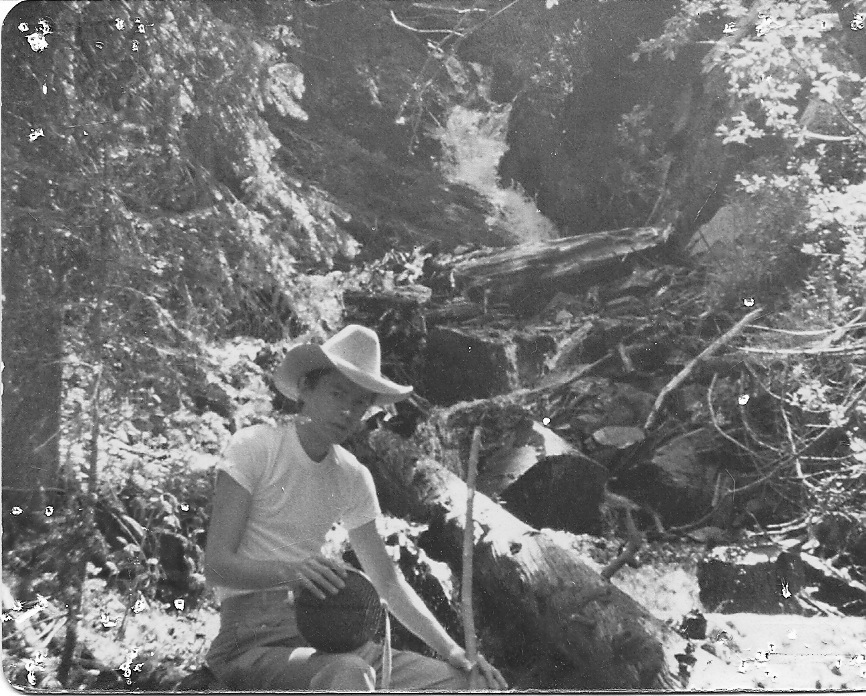 |
Danny pauses for a drink at the headwaters of Thorn Run Hollow, right below what is now Montour Country Club. This spot was just below Indian Ridge Point, a favorite destination either for a lunch stop on long day hikes or a camping spot on weekend trips. In his spare time during a career writing, teaching and coaching, Danny was the advisor for a Venture Outpost, the modern coed version of what was Explorers and Campfire Girls, the high school version of Boy Scouts and Girl Scouts. He took students skiing, backpacking, canoeing and surfing with annual expeditions into the nation's wilderness areas. His outpost was named the outstanding unit in Kentucky three times and in the nation once. Giving that up once he moved to teaching at the university, he created http://www.OutpostUSA.org, which is an adventure travel planning website for youth groups and families. |
If you had a relative who worked at Dravo, you could snag a season pass and either bike or drive over there every day all Summer to swim in their huge outdoor pool with its grass beaches and concession stands. Otherwise, your best bet was The Chute, a classic woodsy Swimming Hole below Wildcat Rock. It was not exclusively a Coraopolis retreat. Situated right below Charleton Heights and the Felician Sisters Convent, it drew a lot of Moon Township kids and even some adults. It was especially good after a rain, as it appears here (notice the muddy water). Just below this pool, the actual chute pours down a rocky slope. A photo of that scene is on the junior high page. Those people too lazy to walk down the Wildcat Rock Trail could drive by turning right off Montour Street at Morgan's Store and going up Brook Street to the dead end, then walking up the level trail. By our junior and senior years, it had become common to bring supplies and stay for the evening, cooking dinner and relaxing before heading home around dark. |
 |
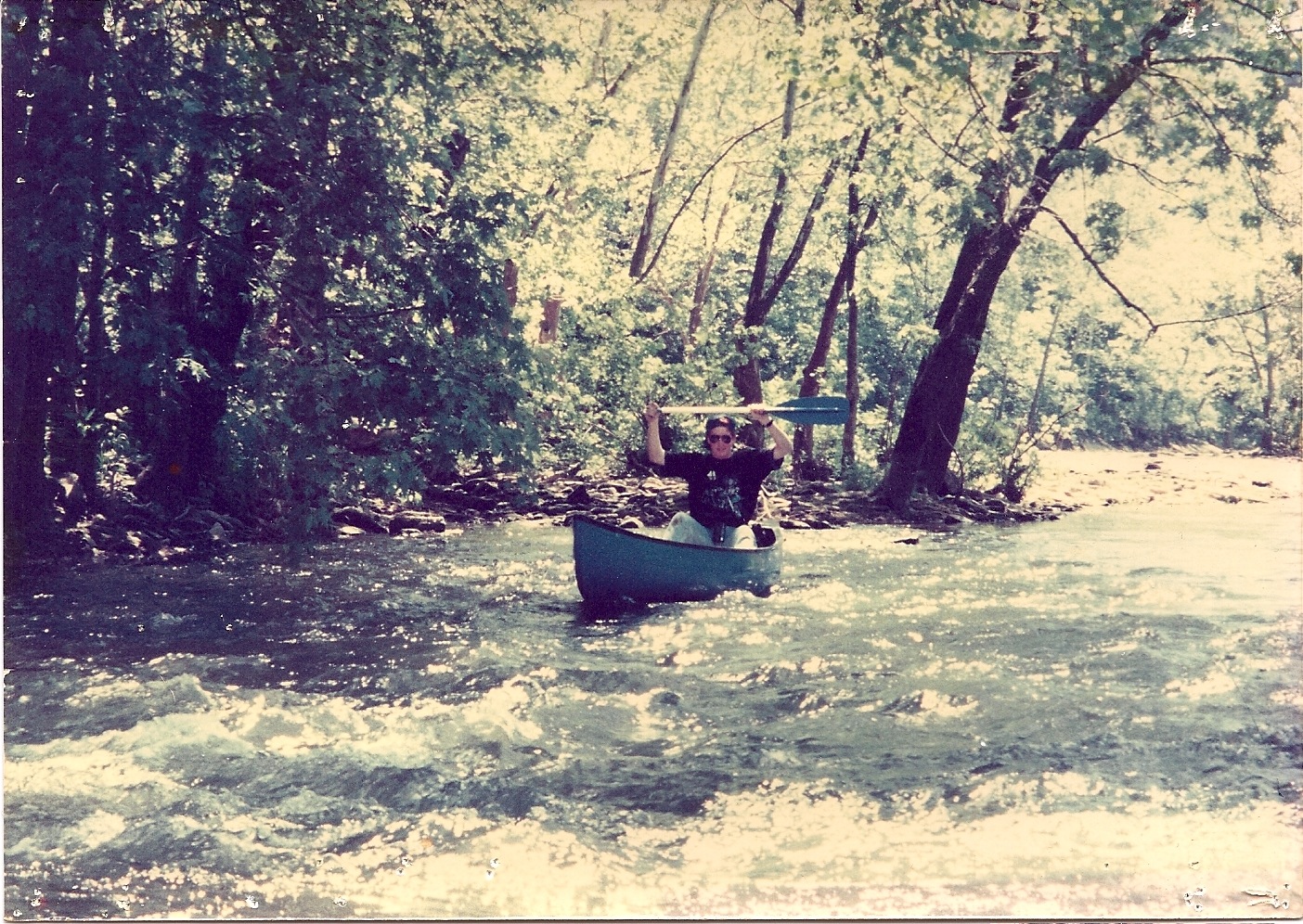 |
Dale glides through some riffles out on Raccoon Creek. By this time he had transferred to Montour and was starring on their football team against us, but still participated in Troop 133 at the Presbyterian Church and had many friends in Coraopolis. Most of us loved canoeing and looked forward to it at church camps, Y Camp Konokwee, one of the Boy Scout summer camps, or weekend trips with local Scout troops to nearby streams. By the time we graduated from high school many of us had become good enough to take a canoe down Class III streams. But we also received instruction and practice and earned certification in water rescue, so if we were out on a creek or river and somebody, whether one of our group or someone else, got in trouble, we were trained and equipped to do whatever was necessary to get them out of trouble. As adults, most of us bought our own canoes and continued to go paddling whenever possible. |
| We had plenty of fund raising luncheons and dinners. Here, Judy, Grace and Elaine serve at the Chile Supper. Seated, from left, are Sandra, Blanche, Shirley, Paul, Glenn, Bill, Joe, Pete and Frank. | 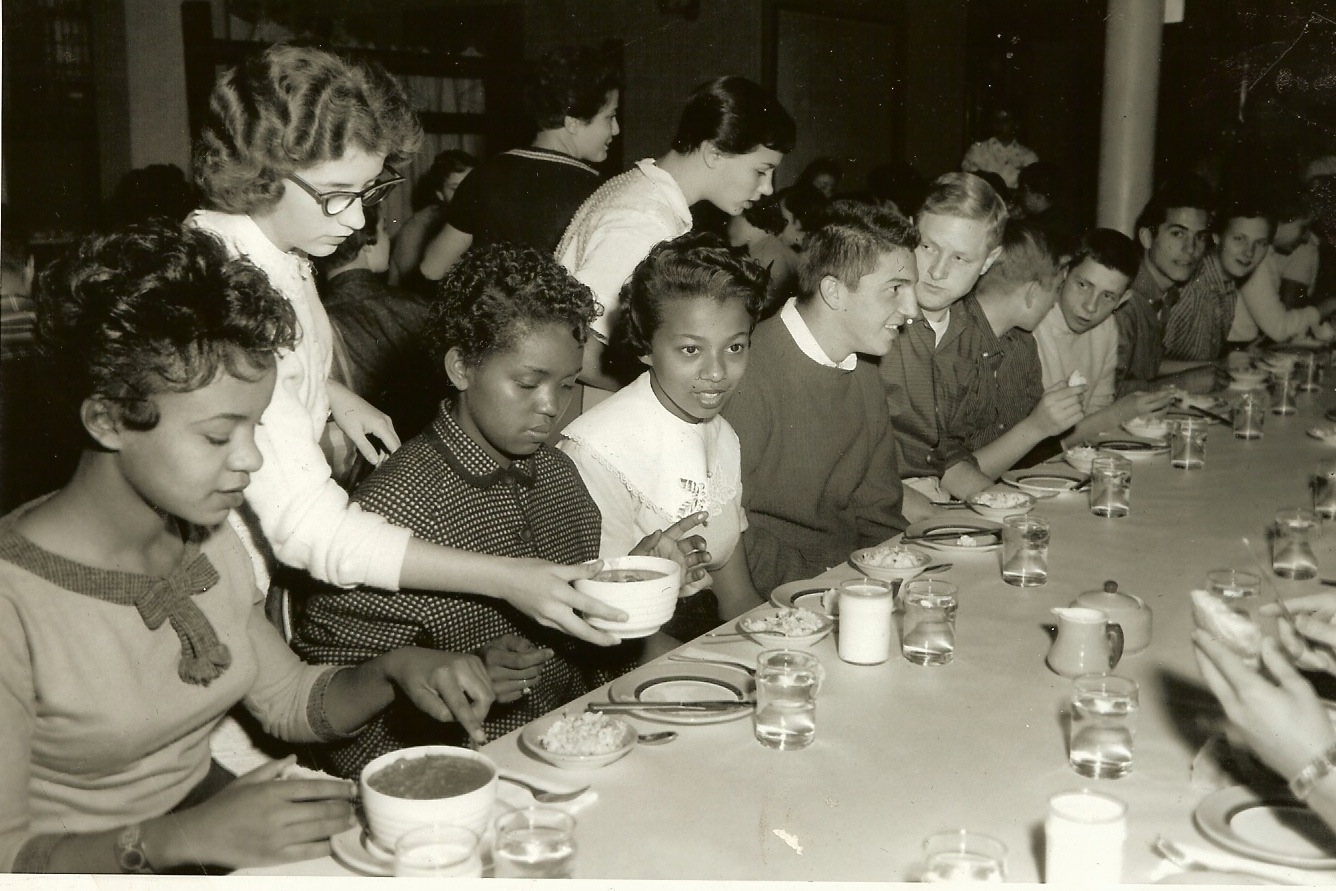 |
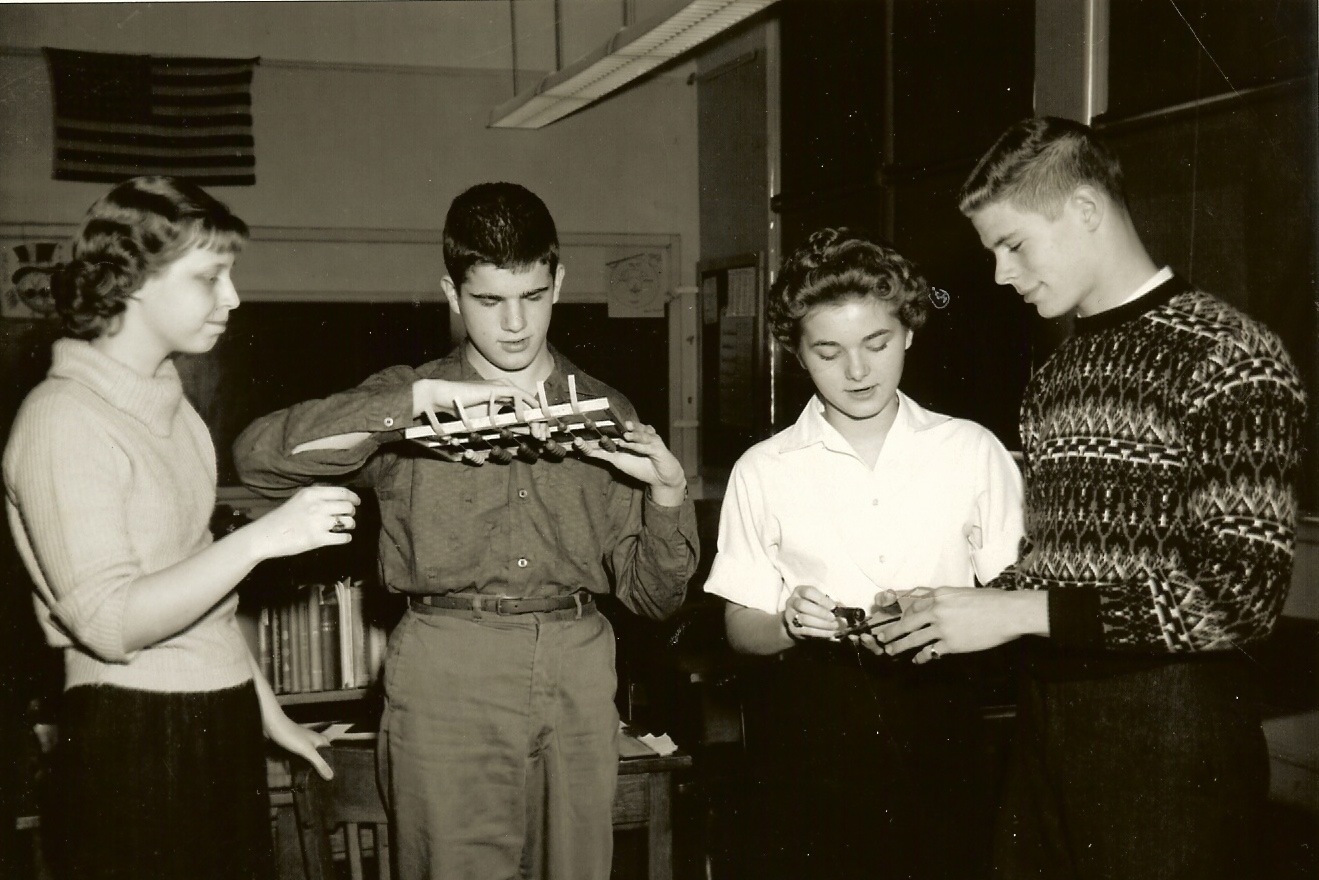 |
From left, Patti Lou Gazdagh, David H, Anita Homich and Bill C fiddle with math related instruments. |
| Back in the fifties, we still had Christmas Assemblies just before school let out for the holidays. As this photo shows, they were a lot of fun. Here, two of Santa's zanier elves, Bill C and David S, escort foreign exchange student Annie Berqvist of Sweden from her seat to the stage, where she is about to be presented with several gifts. Seated closest to the camera, coming down from left, are Nick, Joyce D and Jeannie. The two girls in front cannot be identified. | 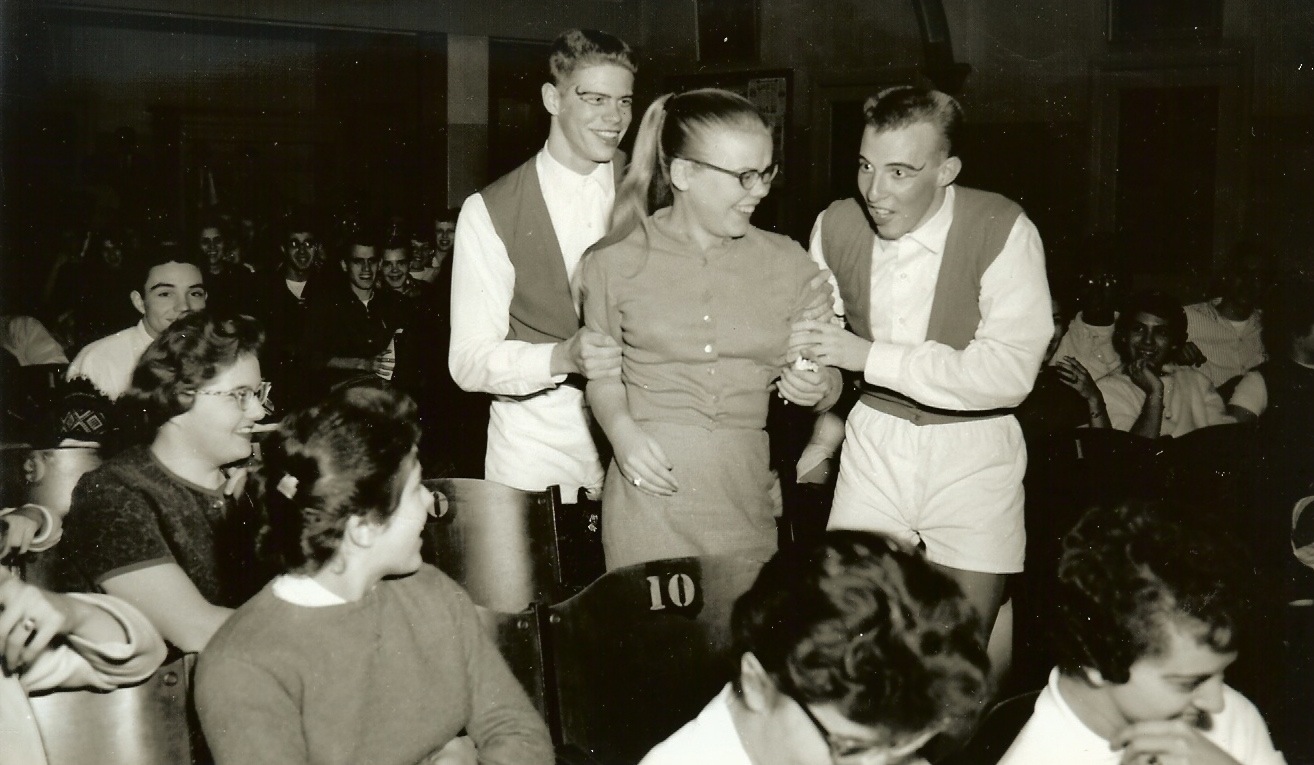 |
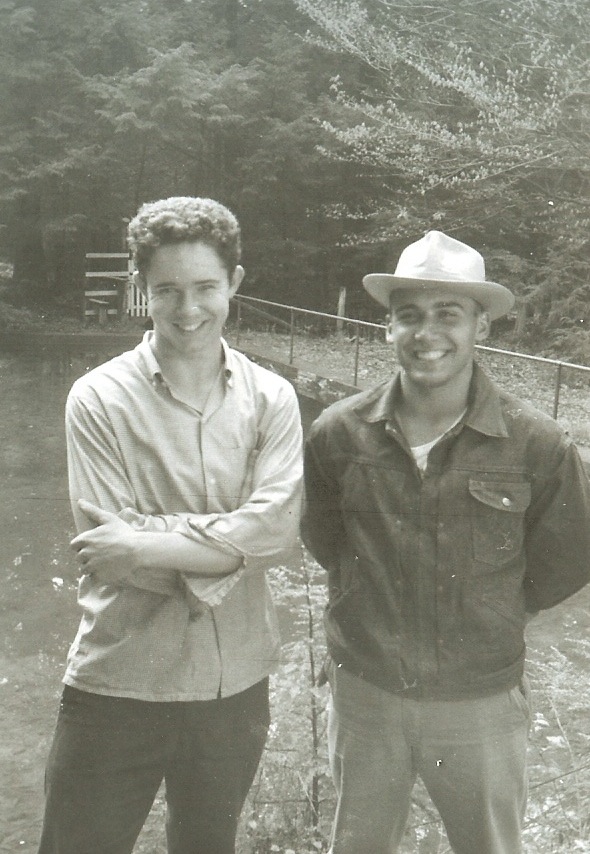 |
Bill P relaxes far from the classroom. In addition to being president of the Buddy Holly Fan Club, Bill was quite an outdoorsman. He would go on to major in Forestry at Penn State and finish with a doctorate in plant pathology from the University of New Hampshire. He spent a career in the U.S. Forest Service, supervising huge tracts in Louisiana and other places, working in Forest Pest Management, Forest Ecology and Tree Nursery Management, before finishing as Superintendant of Tongass National Forest in Alaska. Always a fisherman, Bill hosts members of our class on Alaskan fishing expeditions (for King Salmon, Silver Salmon, Coho Salmon and Halibut), and enjoys hunting Brown Bear. He hosts friends from the Lower 48 on bear hunts for considerably less than the usual $10,000 guide fee, but as Bill says, "you get what you pay for." Unlike professional guide services, he doesn't guarantee his guests will actually get their bear. Since moving to Alaska, Bill has also become a self taught home builder. He's built three so far and is working on a fourth, this one for his oldest daughter. |
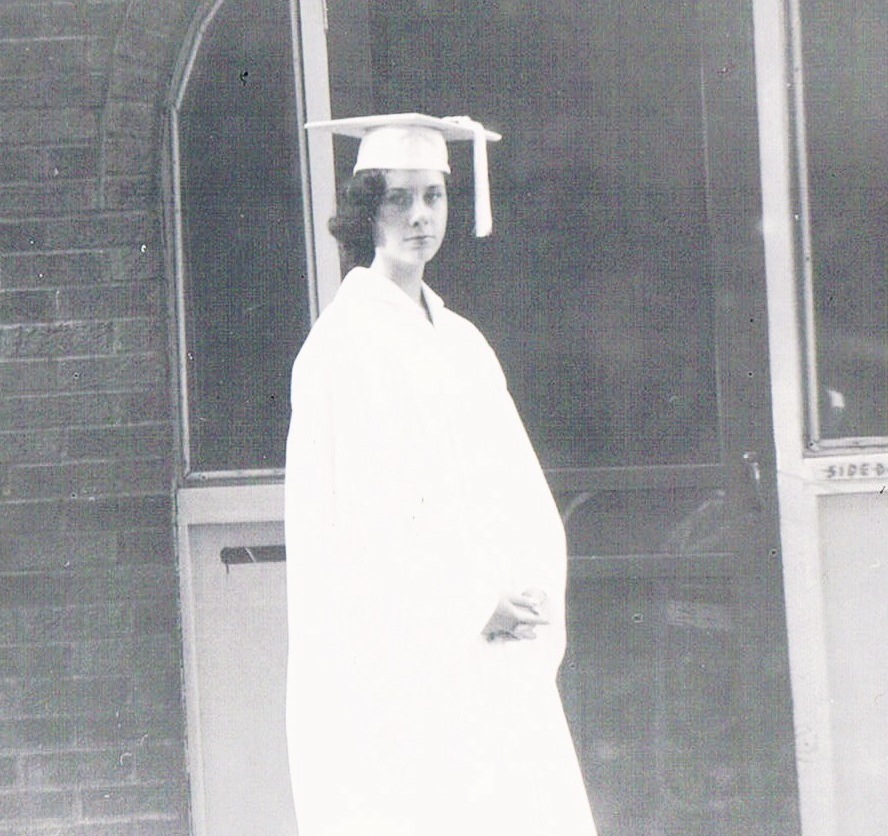 |
Marilyn poses before heading to evening graduation. Notice the Chrysler in the photo at right, with its classic 1950s tail fins. Also notice the brick streets, a long time tradition we paid little attention to. | 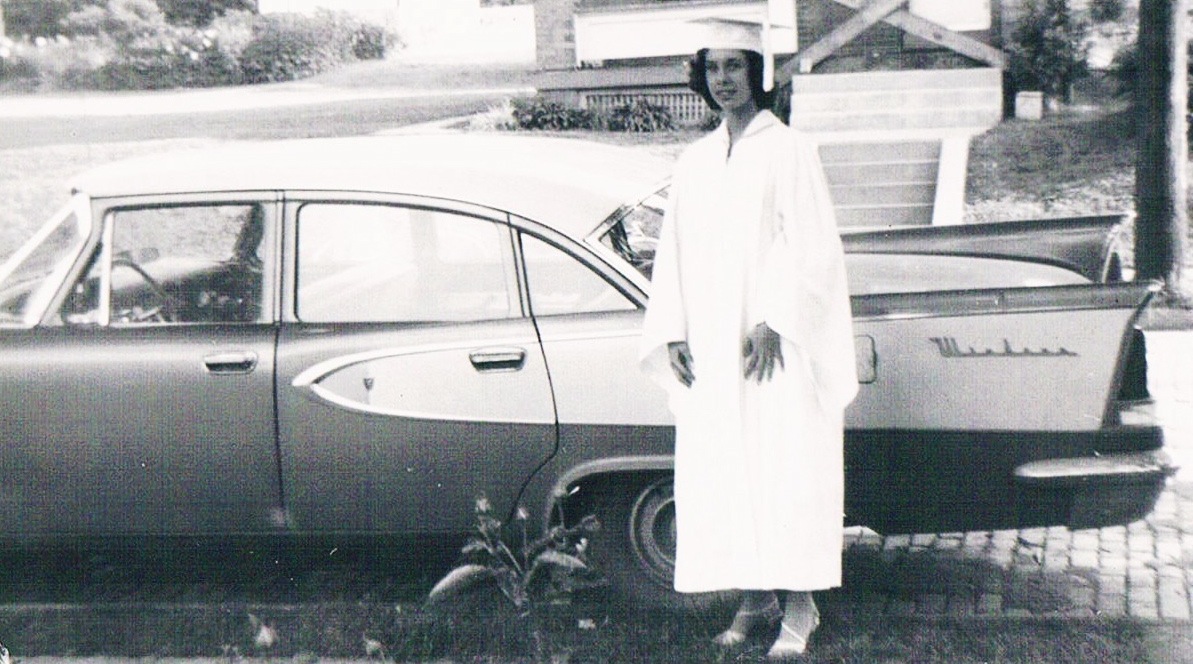 |
Just because we had drivers' licenses, part time jobs and sports didn't mean we forgot about sledriding. Lynette is shown in December 1957 (our 10th grade Christmas) up at Omlors Hill. A lot of the Lincoln kids had gone there when they were in grade school because it was off road and when they got cold Mrs. Omlor was happy to fix them hot chocolate while they warmed up by the fireplace. Lynette moved from Lincoln over to the center of town but still returned to Omlors a few times a year to sledride. There was usually a gang up there, especially on weekends. "First Tracks" was a special privilege, getting there before everyone else so one could go down the hill a few times before the snow was all packed down. In these photos Lynette is making the first few descents. Later, as the snow is packed into ice, it becomes much faster and trickier to steer. Like the streets and other major slopes, it was a great ride down but a long hike back up, towing the sled behind. It wasn't the cold or the riding that wore us out; it was the 30 or 40 hikes back up the hill. No wonder none of us were fat. The girls had a huge advantage in that they could buy hooded coats. Companies did not seem to make hooded coats for boys, so they had to wear scarves, earmuffs and bomber hats. Long underwear, wool sweaters and heavy buckle rubber boots were the standard clothes. |
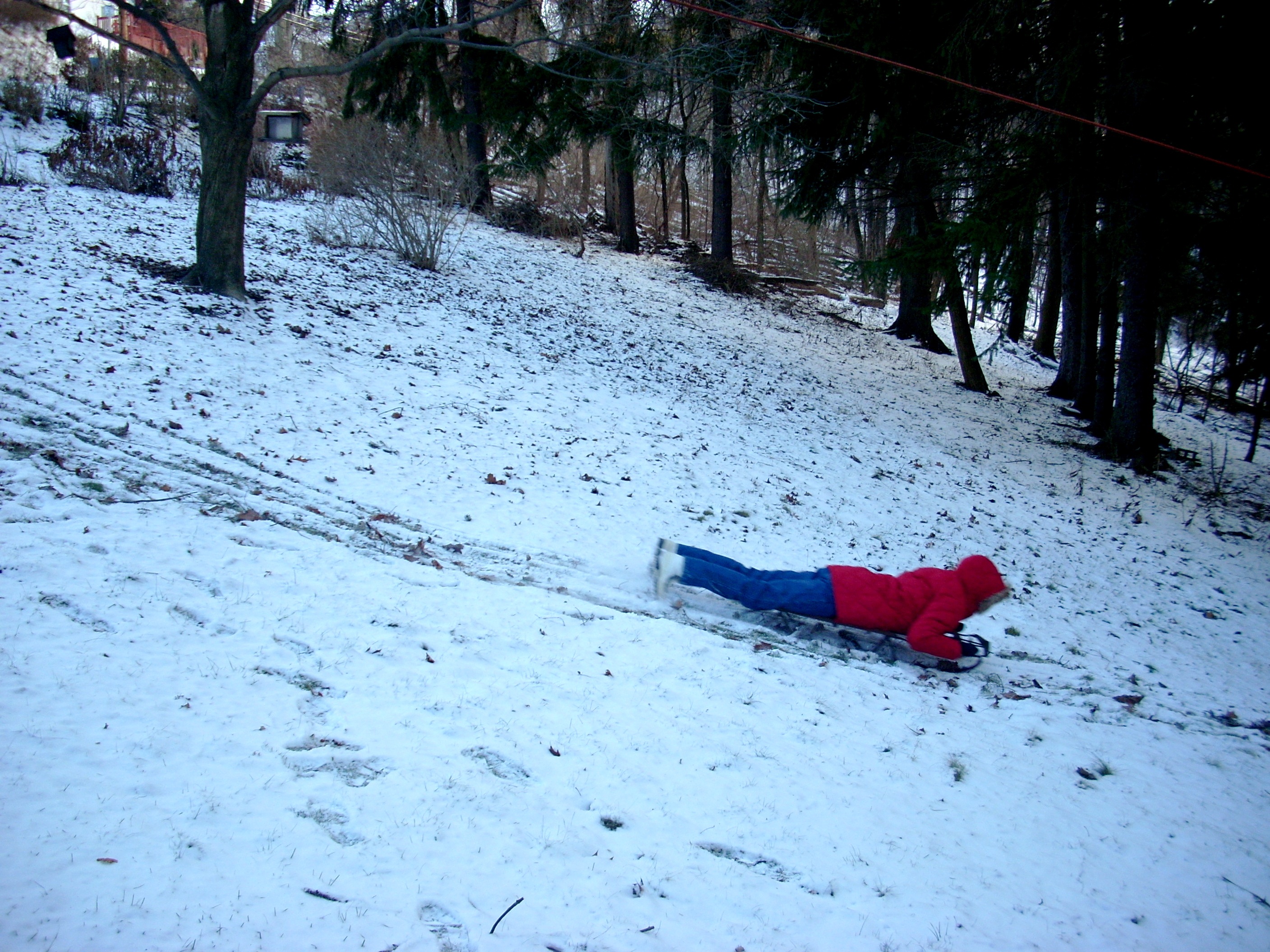 |
 |
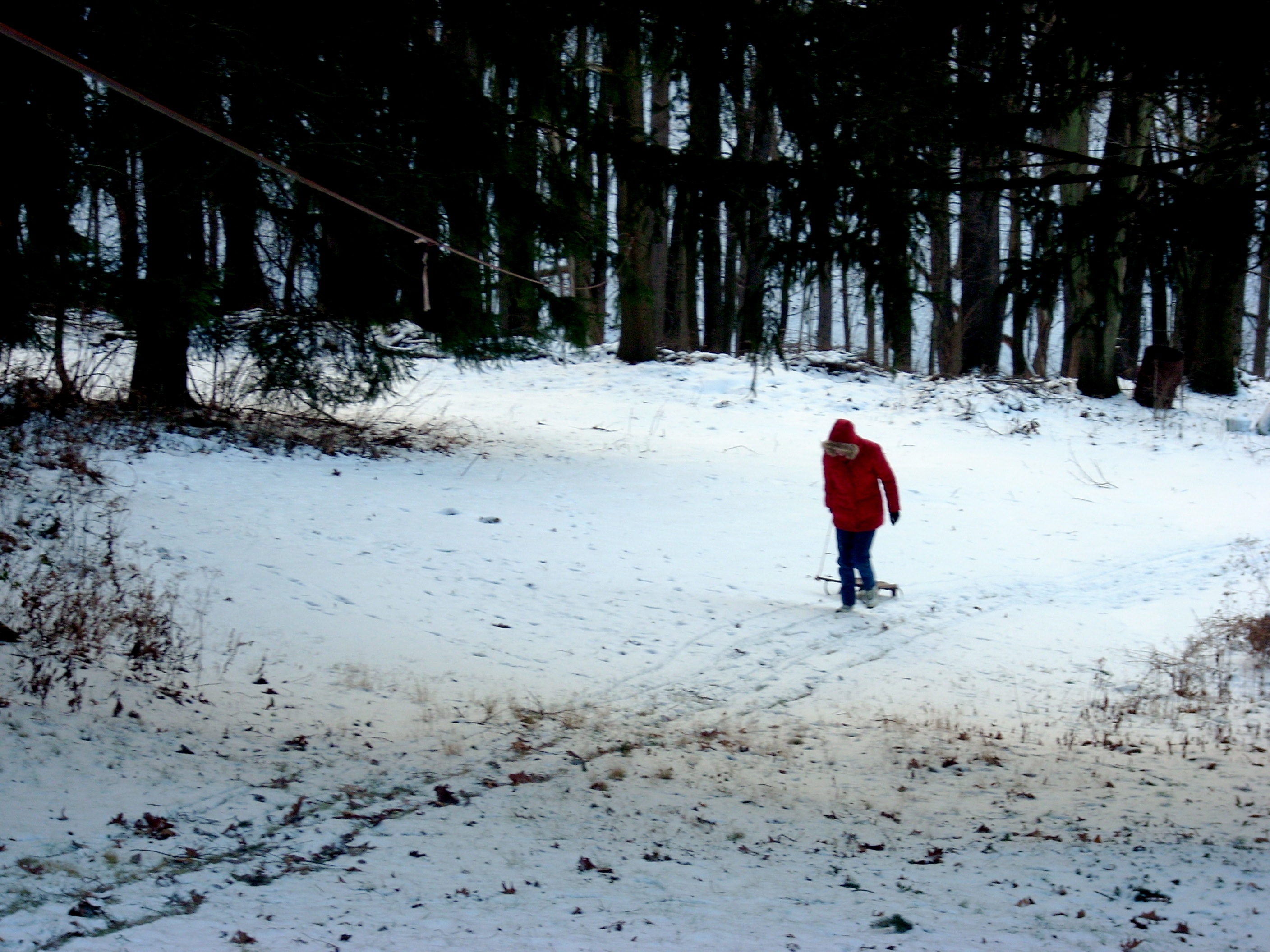 |
 |
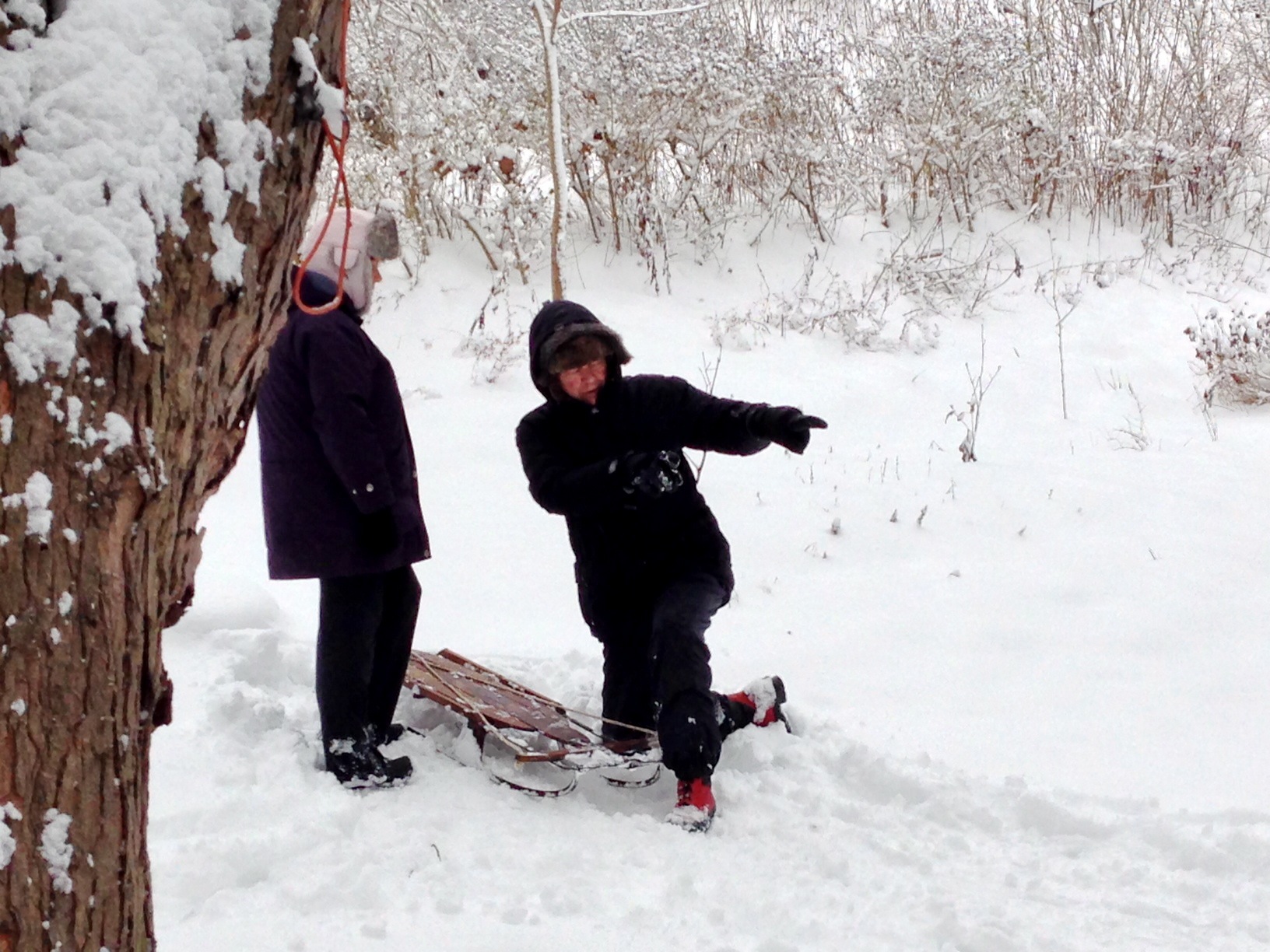 |
 |
| As we moved from junior high to senior high, a lot of kids dropped out of Girl Scouts and Boy Scouts. But not all. Some of us stayed in all the way through high school graduation and beyond. Among the boys who stayed in, one of the great events of high school was the 1957 National Jamboree at Valley Forge in the July before we began our sophomore year. Shown here are John (in sunglasses), Chuck and Frank posing along the road on the way into the national park, where there were 55 banners representing each contingent at the event (each state and territory plus several foreign countries). The Jamboree was an eye opener for us small town boys. Over 100,000 Boy Scouts from all over the country arrived by train and bus for two weeks of celebrating American history and heritage. Included were full day sidetrips to Washington and Philadelphia and shorter visits to Trenton (NJ) and the Delaware Water Gap. President Dwight D. Eisenhower and Senator John F. Kennedy headed a long list of important national figures who walked through our campsites and spoke at evening ceremonies. | 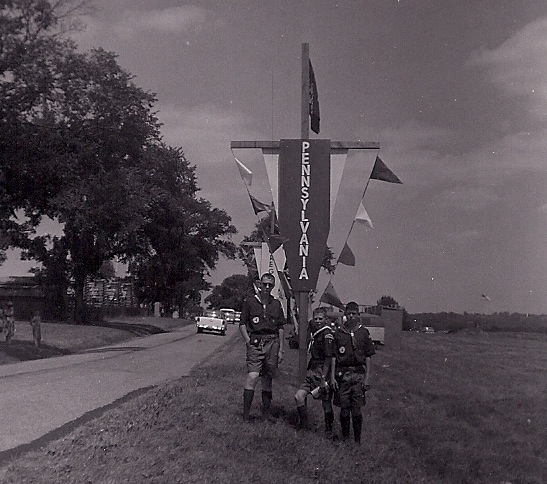 |
 |
Chuck (left), John and Frank here inspect one of the log cabins built by George Washington and his men as they established a Winter camp at Valley Forge. It was one of the coldest Winters ever recorded in North America, with some of the deepest snow, and the Colonial troops had a terrible time, but the British assumed few would survive, and withdrew to Trenton to enjoy the warmth and comfort, figuring they would round up the remaining Americans, if any, after the Spring thaw. While they were not paying attention, an idealistic French nobleman, the Marquis de Lafayette, arrived with his personal fortune, ships of food, weapons, ammunition and warm clothing, and his Dutch companion, General Von Steuben, took over the training of the Colonial soldiers. On Christmas Eve Washington launched the famous crossing of the Delaware in a blizzard, surprised the British, captured Trenton, and suddenly what had been a hopeless case became a serious war. It would take another year, but the Americans left Valley Forge on their way to winning the Revolution. The feel our dozen Coraopolis kids gained for the American Revolution from our two weeks at Valley Forge would remain with us for our entire lives. We met boys our age from all over America, came home with patches and slides and live animals like Texas Horned Toads, but most important we came home with a personal relationship with George Washington, Colonel Parker and Lafayette. |
| Lynette and Lucy pose on the front porch of the Y in May, about three weeks before graduation. Fun loving Lynette, always smiling and full of life, would be the first of our classmates we would lose. Of the 67 of us who would graduate from a major four year college or university, Lucy would become one of only six to actually return to Coraopolis to spend their careers here. Although retired from full time teaching, she still serves the Cornell School District as a sub and in 2010 nominated Judy to the Wall of Fame. | 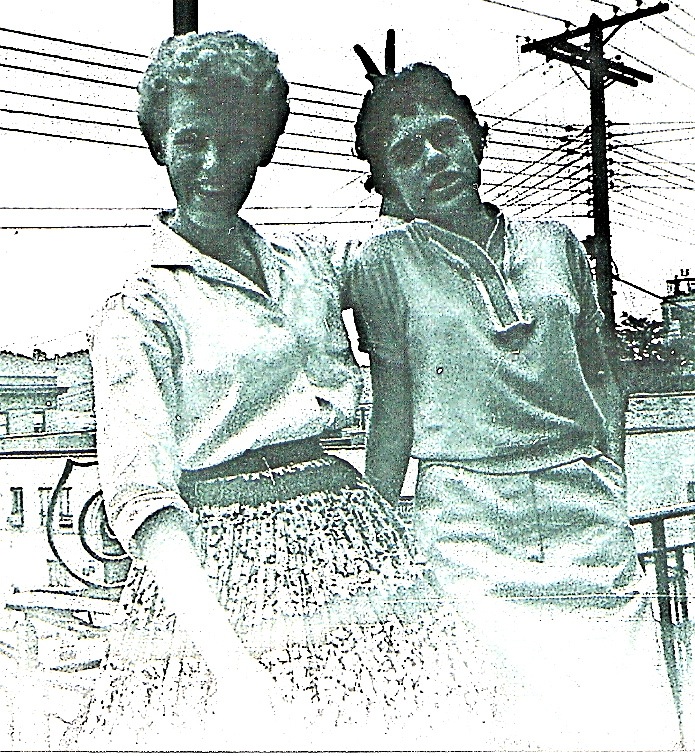 |
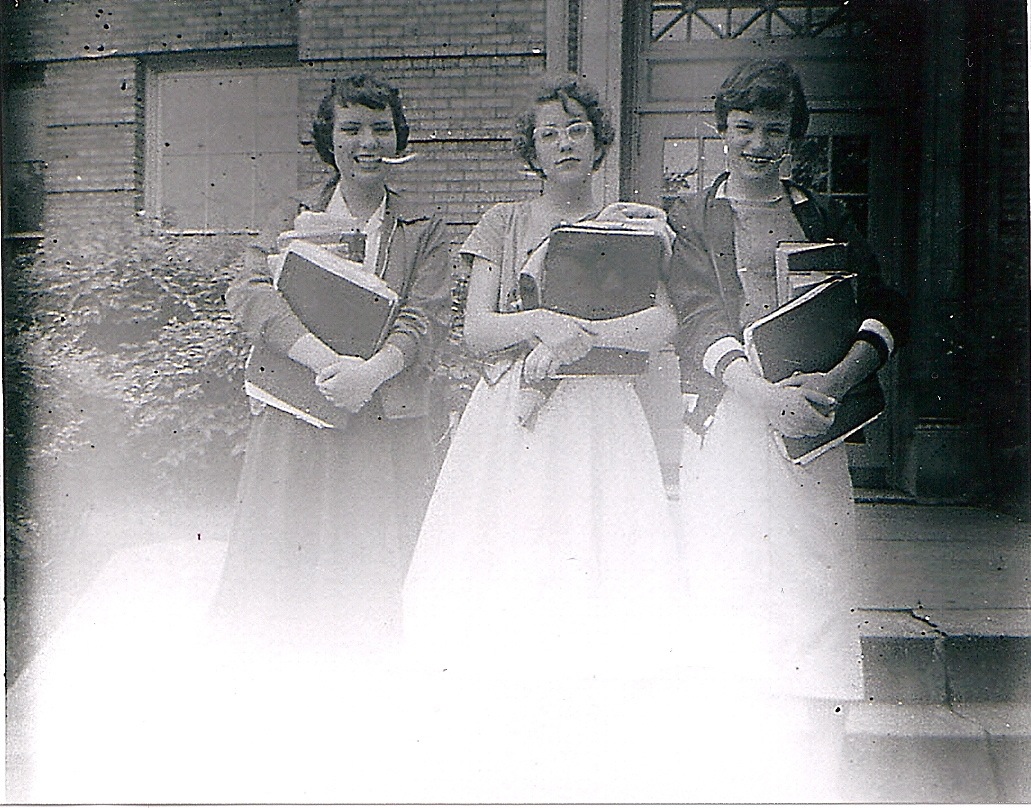 |
Linda (left), Judy and Grace head home from school on an April afternoon. Bookbags and backpacks were not in fashion when we were students, so we had to haul our books and supplies by hand. Guys held theirs with one hand down at their sides, while girls carried theirs in both hands as shown here. Compared to our kids and grandkids, we had MUCH more homework. Those with high grade averages spent most of every evening on the kitchen or dining room table, the living room floor or at desks in our rooms. And unlike our kids' and grandkids' teachers, ours did not begin to wind down in the last six weeks. Instead, they usually increased the intensity as they tried to finish the textbook or complete the work they had planned for the year. |
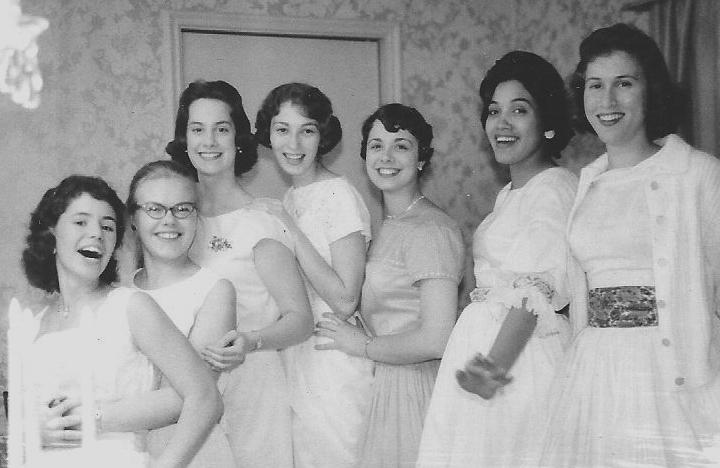 |
A fond farewell. Seven of our finest celebrate at a graduation party in June 1960 at Carol's house on Vance Avenue. From left are Jean, Annie, Anne, Mary Kay, Carol, Harriet and Michaele. |
| Deceased: Lynette Pitts, Don Shaffer 9-73, Tom Talerico 11-22-95, Joyce DeWalt 2-5-96, Chuck McChesney 11-9-96, Elaine Deramo 4-4-99, Rita DiClemente 12-19-2000, Joyce Brown 2-2-01, Glenn Purdy 2-3-2001, Dave Duncan 7-7-2001, Bob Craig 12-4-03, Al Sambolt 3-3-04, Paul Pugleilli 2-19-06, Ed Smith 8-16-06, Al Sellers 11-06, Maryann Soza 2-25-07, Nicky Hutsko, Margaret Whitney 3-16-14, Linda DiCicco 10-19-15, Pete Cortese 6-29-12, Bill Pawuk 11-25-12, Frank Spaniol 4-14-19, Harriet Rossi 1-20-20, Nick Spinelli 2-24-20. |
| Please email your photographs to Cory at Coraopolis60@aol.com. We especially need photos of the Friday Night Club; high school baseball; various scenes at the YMCA; junior high football or basketball; classroom scenes in elementary or junior high; various students' cars; school holiday decorations such as Christmas trees; students in their homes with their Christmas trees or model train layouts; and field trips. We need photos with recognizable faces. Do not send original photos by mail; they are too valuable and it is too risky. |